

The fascinating history of the hotel industry
Disclaimer: Some posts on Tourism Teacher may contain affiliate links. If you appreciate this content, you can show your support by making a purchase through these links or by buying me a coffee . Thank you for your support!
The history of the hotel industry is a long one. Dating back to ancient times, hotels have played a key role in the growth of the tourism industry. But hoe has the hotel industry changed over the years?
In this article I will provide you with a brief history of the hotel industry. Read on to learn more…
What is a hotel?
The first hotels, the history of hotels: the middle ages, the modern hotel industry, hotels in the 18th and 19th centuries, the history of hotels: the 20th century, the internet and its impact on the hotel industry, the post modern hotel industry, the first hotel in the world: nisiyama onsen kiunkan, further reading.

Before looking into the history of the hotel industry, it is important to recognise what a hotel is.
A hotel is defined as an establishment providing accommodation, meals, and other services for travellers and tourists .
A hotel is somewhere where one can sleep away from their home. This could be for a holiday or for business purposes, or for convenience when travelling for any other reason such as a hospital appointment in a different area. They are short-term lets ranging from one night to a few weeks.
Hotels take all shapes and sizes and there are a variety of different types of hotels found throughout the world. In fact, the nature of hotels has changed and evolved throughout the years- the history of hotels is a long and interesting one!

Hotels go back to ancient times. Not in the way we know them, but right back to the early days of civilisation.
In those days there were places where you could exchange money or goods for a roof over your head for the night. This was especially important at this time because journeys were taken by foot (or horse and cart, later), so getting places took much longer than it does now.
While this matches the concept of a hotel as we know it, it was often just a room in somebody’s home . Often it was actually an outhouse! At this point, hotels were somewhere to stay out of necessity as part of a journey – rather than somewhere to make a journey to.
However, savvy ancient business men realised that this was something they could expand on.
In the Ancient Roman times, society began to see more of what we would equate to today’s hotels.
Hospitia, derived from the word hospitality, was used to describe rooms rented in private homes, as explained above. Over time these were commercialised.
The hospitia started to offer food and drink as well as somewhere to sleep, and became somewhere that people would travel to for relaxation and holiday purposes – the upper classes, that is!
One example is the House of Sallust, a popular hotel in Pompeii before the city was destroyed. This is now a popular dark tourism destination .

The history of hotels is a slow one.
During the middles ages inns and staging posts were established as rest spots for travellers, while abbeys and cloisters also offered places for tired travellers to spend the night.
Inns cropped up around Europe and the rest of the world, but travelling during this time wasn’t particularly safe and/or common. Pilgrims, couriers and government workers were most likely to uses these services.

The hotel industry as we know it started around the fifteenth century.
In France and England, laws were introduced that meant inn keepers and hotel owners must keep a guest register. Around 600 inns were registered in England at this time.
These were precursors to the modern hotel, and very similar to what was offered in Ancient Rome and Ancient Greece. There were just more laws in place now!
These inns provided food and somewhere to sleep as well as stabling and fodder for any horses within the travelling party.
Typically, an inn would consist of an inner court with bedrooms on either side, kitchen and parlour at the front, and stables at the back.
Coaching inns were vital before the introduction of rail travel . In England, these were about 7 miles apart and there were up to 10 in any one town. There was plenty of rivalry between inn owners!
They allowed horses to be switched out so the journey went as smoothly as possible. Still, at this point, few people were travelling for ‘leisure’ purposes except for the very wealthy. It was mostly the mail coaches and business trips.
In order to adapt and try to become the inn of choice in any one town, inn owners started running their lodgings in a more professional manner. This meant proper timetables and fixed food menus. This is where we start to see likenesses to the modern hotel industry!

The history of hotels has not changed massively since the 18th century.
During the middle of the 1700s, hotels simply grew and provided more. As wealthy people were beginning to explore further afield and travel became more of a leisure activity than it ever had been (e.g. the upper classes of ancient Greco-Roman culture ), hotels had to become grander and give their guests something else.
One of the first modern hotels to open was in Exeter in 1768. This was followed by the City Hotel in NYC. However, it wasn’t until the early 1800s that people took the idea on board and hotels started to pop up throughout Europe and North America.
Mivart’s Hotel opened in London in 1812 (later becoming Claridges), while Tremont House in Boston , USA opened a few years later in 1829. Tremont House holds the record for many industry firsts. It was the first hotel to have indoor plumbing with toilets and baths, as well as free soap (a tourist favourite) and a proper reception desk area which did more than just take payment. As time went on, more and more hotels opened.
Thanks to the industrial revolution, there was regular but structured work so people had more income as well as time off. Travel started to be more accessible and more appealing.
With the invention of trains and cars as well as reduced working hours and other benefits, travel was no longer something only the wealthy could do! Demand lead to a turning point in the history of hotels as they increased in popularity hugely. By the 1900s, there were many hotels around the globe.

As the physical aspect of travelling got easier and became more commonplace, the hotel industry boomed.
The second half of the 20th century saw a massive boom in the economy, too. This meant that the population grew, demographics completely changes and many places became more urban. As the desire to travel increased, so did the different types of hotels.
The boom in hotels was a prominent part of the history of tourism . With travel becoming a more popular activity, there had to be plenty of variety. This is why we now see beach resorts and motels, golf resorts and budget hostels around the globe.
The diversity within business meant that different target audiences were catered to! It is also meant prices could vary depending on what particular hotels were offering. Hotel categorisation brought a whole new level to the industry.
And of course, international travel opening up meant that hotels and resorts around the globe had a whole new clientele to cater to: foreign tourists . People were no longer just travelling domestically . They were now visiting other countries to explore, staying for longer time periods and expecting more out of their trip.
So… while the concept of a hotel hasn’t really changed since time began, they have always had to adapt to the next big thing…

Like with everything, the history of hotels was impacted by the internet.
The travel industry responded quickly to the rise of the internet, and continues to do so. Internet access means people have more choice. It means it is easier to book things like hotels (as well as flights, transfers and car hire) without having to leave your house. You can compare the prices of hotels, reserve without payment and cancel for free.
The digital age has meant the travel industry has needed to adapt. However, it has also presented new opportunities for hoteliers and other industry professionals.
With thousands of options at their fingertips on sites like booking.com , avid travellers are able to read reviews and see real-time price updates for hotels in their own area or in far-flung corners of the globe. Tamara Lohan from Mr & Mrs Smith, a boutique hotels website, told the Guardian: “We pivoted from a hotel guidebook to become an online travel agent just as the internet started to become a place people could finally trust with their credit cards. In the whole of that first month online we did 10 bookings – now we do 300 a day.” While she says the business changed its model due to internet and allows online bookings, it still runs 24/7 customer service support via phones “for people who want that human element”.

What is the future of the hotel industry?
In recent years we have seen a significant growth in the sharing economy. The concept is simple- peer to peer transactions are becoming increasingly popular over traditional consumer purchases.
So what does this mean for the history of the hotel industry? Well, recent times have seen a decline in hotel bookings and reductions in prices in some areas. One of the main culprits is Airbnb, but there are other similar platforms too. Airbnb allows people to share their accommodations with other travellers.
In the future, I predict further moves towards platforms such as Airbnb . I also predict, in response to the 2020 COVID outbreak, an increased importance placed on cleanliness at hotels.
With the growth of niche tourism and an increased consumer desire for the new and the different, I also predict that we will see more unique hotels pop up throughout the world, such as ecolodges and themed hotels.

A blog post about the history of the hotel industry would not be complete without mentioning Nisiyama Onsen Kiunkan.
According to the Guinness Book of World Records, this is the oldest operational hotel in existence. You can find it Yamanashi, Japan. It opened in AD 707 and has been open ever since, run by the same family for forty-six generations. The hotel was given the title in 2011.
The Nisiyama Onsen Kiunkan is a four-star hotel with 35 rooms decorated in beautifully Japanese-style decor. The rooms have free-flowing baths and stunning views of the Kai Mountains as well as the Hayakawa and Yukawa Valleys. You can book a stay at the Nisiyama Onsen Kiunkan and experience it for yourself!
Now that pretty much sums up the history of the hotel industry. Are you interested to learn more about the hotel and tourism industry? I have lots of articles that I’m sure you will LOVE! Here are a few of my favourites:
- Homestay tourism: What is a homestay?
- Types of rail transport | Understanding tourism
- The sex hotel: What, where and why
- The tour operator: What, why and how
- Visiting friends and relatives (VFR): A simple explanation
- The appeal of tourist destinations | What attracts tourists
- Types of accommodation | Understanding tourism
Liked this article? Click to share!
When you walk into your hotel, the staff will greet you by name, know your travel preferences, and anticipate your needs. Almost every aspect of your stay will be personalized to your tastes, and you can reconfigure your room at any time to make it suitable for work, exercise, socializing, or sleep. For all leading hotel brands, the well-being of both guests and employees—and the health of the planet—will be top priorities. Welcome to the hospitality industry’s next normal.
The view to 2030 and beyond
Hospitality that benefits people and the planet, more on the future of travel and hospitality.

Three innovations to solve hotel staffing shortages

Travel startups: Disruption from within?

The path toward eco-friendly travel in China
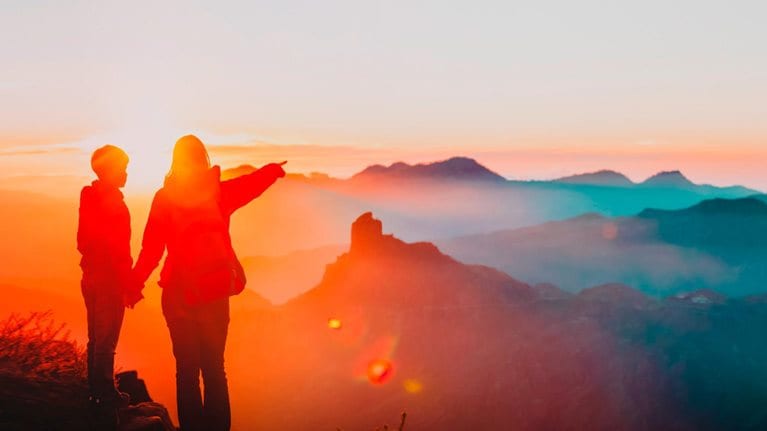
Accelerating the transition to net-zero travel

How to ‘ACE’ hospitality recruitment
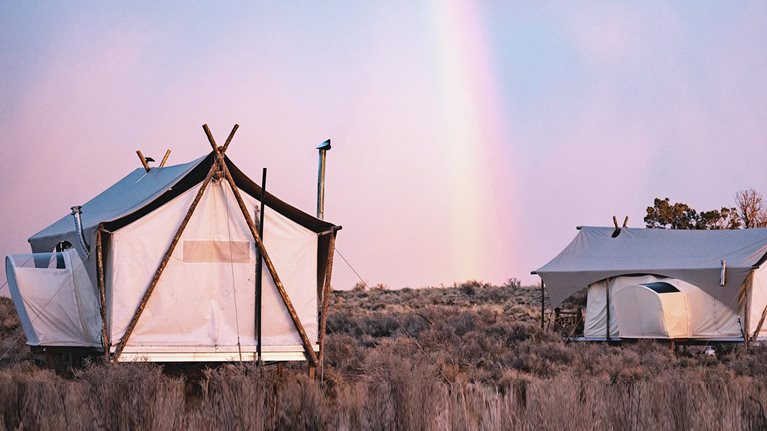
Rebooting customer experience to bring back the magic of travel
The next normal explores the future of grocery, college, video entertainment, and more., latest editions of the next normal, the future of biotech: ai-driven drug discovery, could this be a glimpse into life in the 2030s, the future of video entertainment: immersive, gamified, and diverse.
- Course Catalog

THE EVOLUTION OF THE TOURISM SECTOR
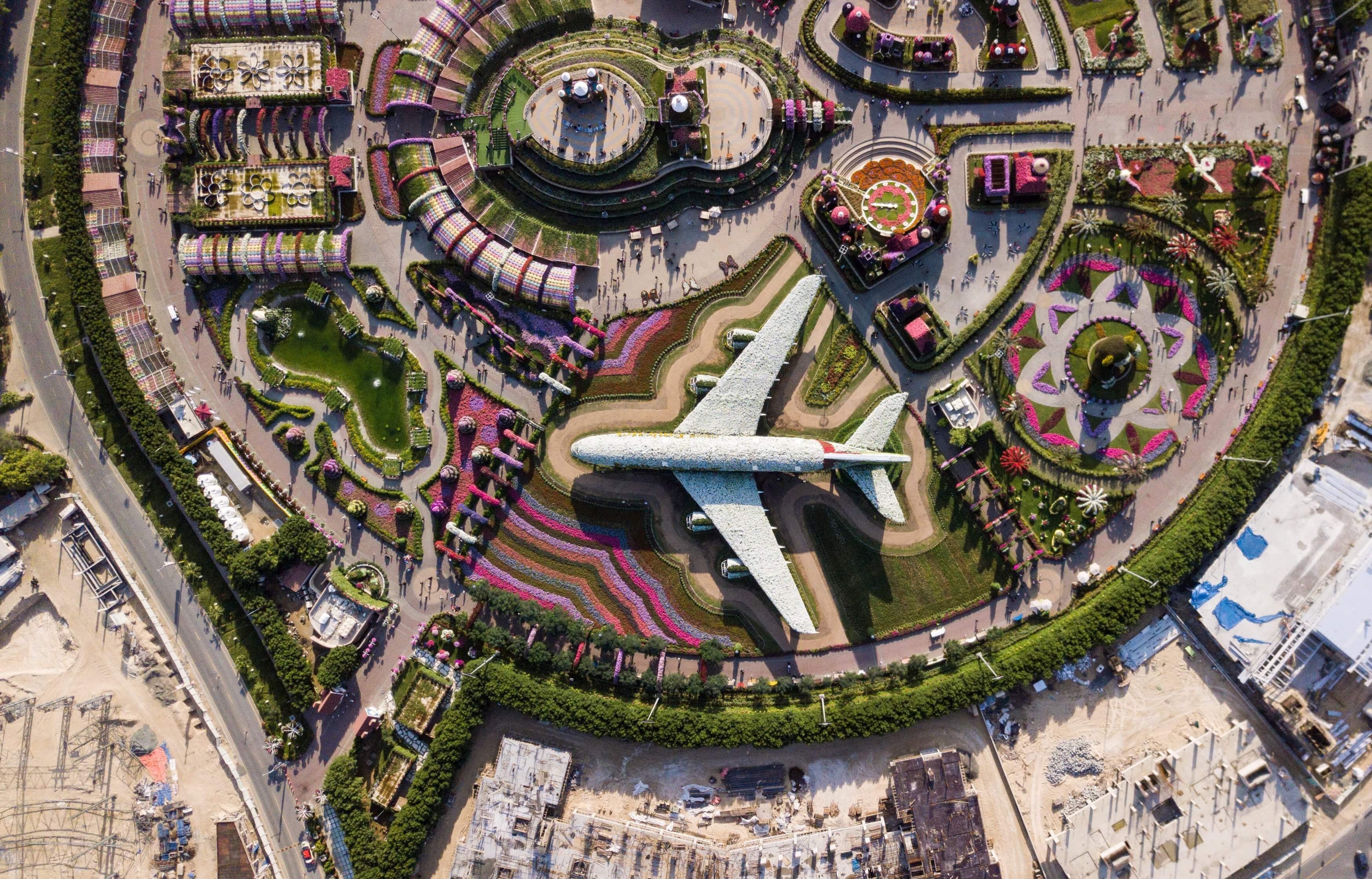
25 Aug THE EVOLUTION OF THE TOURISM SECTOR
Tourism has evolved hand-in-hand with changing technology, communications and marketing practices.
While in 1950 the world welcomed 25 million international tourists, according to UNWTO data, by 2019 this had increased to 1.5 billion.
The massive increase in the number of people joining the middle classes globally, along with the falling cost of travelling, the emergence of low-cost airlines, and the rise of the internet and its impact on both social interactions and business models, are among the main factors behind the increase in tourist numbers.
- Thanks to the internet, almost everyone can easily buy a plane or train ticket, often at a low cost.
- The creation of new companies and market niches help consumers access travel in a more efficient and simple way, eliminating third parties. Travel agencies are being left in the background because of this.
- New accommodation and transportation platforms have also increased levels of competition and lowered costs for tourists.
So, what was seen as a luxury available to just a small few in 1950 had by 2020 become an achievable aspiration for a large number of people in every part of the world.
While the situation for tourism in 2021 is characterized by its response to the COVID-19 pandemic, the sector continues to adapt in order to restart and grow back stronger and more sustainably.
- Hospitality Industry
Top 10 Trends in the Hospitality Industry in 2024

January 10, 2024 •
15 min reading
What are the latest trends in the hospitality industry? As a testament to its resilience, agility and innovative spirit, this article reflects today’s increasingly dynamic hospitality industry in terms of its long, medium and short-term evolution. Discover the industry's adaptability and forward-thinking approach, shaping its trajectory in the face of challenges and opportunities, while staying attuned to the latest hospitality trends.
Best-selling author, Will Guidara, claims “We are entering into a hospitality economy” – suggesting that what underpins the essence of hospitality, (service excellence, human interaction, personalization and the co-creation of memorable experiences), is actually what many sectors of industry are desperately in need of today.
As we charge at break neck speed towards an ever-more digitalized society , the hospitality industry stands out as the successful hybrid that balances the implementation of tech innovation for improved operations whilst preserving the human need for connection, authenticity and real-life discovery.
With statistics predicting a healthy expansion of the sector (e.g., the bleisure and wellness markets on the up, room demand set to reach an all-time high, booking.com as the most valuable tourism brand in the world, and new positions opening up in the sector), we can confirm that the hospitality industry is poised for a significant transformation in 2024.
So what new trends are emerging? Driven by interlinked factors, including technological progress, evolving consumer preferences and a deeper focus on sustainability, hospitality businesses can capitalise on emerging opportunities to enhance guest experiences and position themselves for long-term success.
10 hospitality trends 2024 - Elevate experiences, embrace evolution
- Workforce empowerment: Transforming challenges into opportunities
- Artificial intelligence and technology: Choosing the best tech to revolutionize hospitality
- Culinary experiences: Putting experiences, authenticity and the senses first
- Bars and drinks redefined: Adding creativity and design to the drinks' menu
- Fine dining: In need of reinvention but full of potential
- Fine wine prices: Navigating the fluctuating vineyard market
- Rising interest rates: The impact on hotel property values and transactions
- Green hospitality: Beyond sustainability to net positivity
- Data-driven decision-making: Data-analytics for optimum personalization
- The power of social media: Crafting authentic narratives
1. Workforce empowerment: Transforming challenges into opportunities
Over the past two years, the industry's biggest challenge has not been attracting customers but rather finding and retaining staff. To address this issue, many hotel groups have begun to make improvements, and there has never been a better time for newcomers to the industry to negotiate better working conditions and salaries.
Today, many hotels offer their staff free or low-cost accommodation , increased wages and reduced peak-time working hours. They also invest in training programs to motivate staff and allow mobility up the corporate ladder. Empowered employees not only have a positive impact on how guests feel and their decision to become repeat guests, but also help attract other employees to build a cohesive, high-quality workforce.
2. Artificial intelligence and technology: Choosing the best tech to revolutionize hospitality
As Chat GPT celebrates its first birthday, we can only surrender to the fact that, like it or not, we have entered into an AI-accelerated world, and consequently, the pace at which the industry adapts has become a pressing issue. But which forms of AI best harness hospitality stakeholder outcomes?
Contactless services: Effortless technology, impeccable stay
Embracing contactless technologies is about redefining the hospitality experience to cater to modern travelers, not just adapting to the pandemic-driven shift toward touchless interactions. Contactless services simplify the guest journey by reducing wait times and physical contact points. Mobile check-in, digital keys and voice or tablet-controlled room automation allow guests to move seamlessly through the hospitality experience. The citizenM hotel brand has pioneered this minimum-fuss check-in and room experience with a hugely successful UX-friendly app.
Other popular tools such as WhatsApp allow hotel staff to remain in constant contact with customers during their stay, respond immediately to requests and thus provide bespoke services. It also streamlines operations by reducing the need for face-to-face interactions and human error, improving service delivery and lowering the burden on a scarce workforce. In line with contactless services , hospitality companies need to prioritise data privacy and security, putting solid safeguards in place to protect guest information against cyber threats.
Technology-driven innovation: Beyond boundaries
At the heart of technology innovation is the ability for managers and employees to centralize information at all times. Migrating to a fully cloud-based solution is a first but essential step . This enables real-time sharing, better service orientation and personalisation of the guest experience, improving all hotel departments.
Robotic systems (as used in the Henn-na Hotels in Japan) optimise processes and increase efficiency in back-of-house operations such as housekeeping or F&B outlets, reducing staffing requirements and allowing managers to respond to problems in real-time and with accountability.
The use of augmented reality helps with staff onboarding, allowing new employees to be put in real-life situations and trained before even entering a room. Pedagogically speaking, as practiced at EHL in the Virtual Housekeeping class, AR provides a more interactive and complete learning environment. Augmented reality also allows hotels and airlines to market themselves in an ad hoc style - an innovative and sustainable approach. Potential customers can better immerse themselves in the facilities and make more informed decisions.
Hyper-personalization: Tailored moments, lasting loyalty
In a world of commoditised practices, guests are increasingly looking for personalized experiences that cater to individual preferences and aspirations . In the hospitality industry, hyper-personalisation means relying on technology-based micro-segmentation to tailor each guest interaction to real-time needs and behaviours. For example, eliminating 'deadlines' such as check-in/check-out/F&B closing times, knowing whether a customer wants to be accompanied through check-in or do it contactless, personalizing room temperature, lighting and amenities or tailoring F&B options promptly and accurately. At Fauchon l'Hotel in Paris clients suggest the menu and define their portion sizes. From a hotel perspective, this enables better dynamic pricing strategies, higher guest-spent for experiences, or tailored loyalty programmes with commercial partners.

3. Culinary experiences: Putting experiences, authenticity and the senses first
The desire to experience rather than simply consume means that experiential dining has today evolved in new ways. Hotels are now required to offer a range of dining options to cater to different customer tastes and, when correctly done, can become a culinary destination where the restaurant is at the heart of the experience and not just an extension of the hotel. A good example is the Grand Resort Bad Ragaz in Switzerland which boasts seven restaurants, three bars, a bistro, a café and a sushi takeaway, (plus an array of Michelin stars and GaultMillau points), unsurprisingly making it a mecca for traveling gourmets.
Experiential design can also allow customers to taste food in a multi-sensory environment that stimulates all the senses, not just the taste buds (e.g., Ultraviolet by Paul Pairet in Shanghai ). Some hotels have started to provide experiences even on a smaller and more dynamic scale. E.g., They offer four-hand dinners (an invited chef cooks with the in-house chef), organise kitchen parties (clients eat in the kitchen), or have a front-cooking area. Specialist cooking classes can complement this. The key here is to offer a unique experience like how to make your own gin, cook local food , or bake bread with the experts.
Another trend relates to children . A menu of unimaginative, standard food à la burger and chips is no longer enough; parents want their children to eat healthier, globally-inspired food with high-quality ingredients. Adding world food or plant-based products and packaging them in innovative ways will make for happy families likely to return.
A final significant trend in the food sector is off-premise dining and digitalisation. Although customers have returned to eating in restaurants since the pandemic, a large proportion mix on- and off-premise dining. Restaurants need to cater to this clientele to increase revenues, as takeaways are no longer limited to fast food but also exist for traditional and even fine dining. This means that restaurants need to reorganise their workflows and operations to cater to in-house diners and delivery, alongside designing appropriate, creative, high-quality packaging and optimising delivery or collection methods to be easy and inexpensive without competing with traditional delivery platforms.
This can also include ghost kitchens focusing only on food production for delivery and takeaway. Post-Covid, ghost kitchens have become an increasingly popular trend in the restaurant industry with statistics showing that they are projected to be a $157 billion market by 2030. As of 2021, there are over 100,000 ghost kitchens operating worldwide .

4. Bars and drinks redefined: Adding creativity and design to the drinks' menu
Today's bars need to stand out by offering unique drinks paired with a special, Instagrammable atmosphere to create an immersive experience for their customers. E.g., Ashley Sutton Design Bars are known across Asia for their ability to transport guests to enchanting, immersive worlds, offering not just a place to drink but an entire experience that stimulates the senses and sparks curiosity.
Gone are the days of a simple wine list and international beer and spirit brands. Bars and restaurants need to specialise and cater to an international clientele with evolving tastes. A dedicated beer menu with local craft beers, wines from specific vintages and terroirs with a narrative, eclectic spirits collections (after whisky and gin, look out for rum in the coming years), and fresh hyper-locally sourced juices are what customers want.
Mixology has been around for some time, but offering mocktails and non-alcoholic food pairings is also becoming essential due to stricter alcohol laws and healthier lifestyles driven by Gen Z and millennials. Faux booze has gone mainstream and now it’s not just a case of ‘dry January’, but mocktails all year long! Cocktail and mocktail innovations should go beyond traditional recipes to include unique ingredients, techniques and presentation styles (e.g., Bar Benfiddich in Tokyo ) and be taught to customers in mixology classes.

The effect of economic uncertainty on hotels, restaurants and fine wines
5. fine dining: in need of reinvention but full of potential.
The pandemic has unexpectedly affected consumer behaviors: they now organize themselves on short notice, have become increasingly spoilt for choice and no-shows are today the norm . More and more restaurants are responding by asking for a credit card at the time of reservation. But this only treats one of the symptoms without solving the problem. "A full house one day, but only four tables occupied the next" , is an observation that led Antoine Lecefel to shut his restaurant – sadly one of many fine dining establishments to do so.
Inflation and declining purchasing power play a part, but more generally, the fundamental problem lies in the inability of fine-dining restaurants to reinvent themselves. Unlike hotels and other players in the hospitality industry that increasingly compete with them through ambitious and innovative culinary projects, they have to contend with limited financial and human resources. They have neither the capacity to implement and manage a proactive strategy nor the means to invest in cutting-edge, highly experiential concepts. Initiatives such as Eatrenalin , which create a unique experience by combining gastronomy, décor and entertainment, offer a glimpse of this changing industry and the new competition facing traditional players.
Solutions? A strong, contemporary concept plus a business-oriented management that understands consumers, connects with them and is thought through from the outset to generate margins and create synergies and/or economies of scale. The Igniv chain is a shining example of this, driven by an extraordinary chef and based on the principle of “we love to share”, Andreas Caminada has created a unique and fully coherent concept, the success of which is now being rolled out in various locations, all of which have been rewarded with rave reviews from customers and expert guides.
6. Fine wine prices: Navigating the fluctuating vineyard market
Another challenge facing restaurants is cellar and wine list management. Restaurants with limited financial resources may even wonder whether fine wines still have their place on their menu . Indeed, fine wine prices have risen almost exponentially since the Global Financial Crisis of 2008. But here, too, the situation appears to have changed.
A year ago, fine wine prices were at record highs. Demand for rare, artisanal wines from regions with long-standing terroir reputations was at its peak. One could go on about Burgundy, but many other examples are as revealing. For example, the Châteauneuf-du-Pape Réserve cuvée from Rayas, worth between 150 and 200 euros (for young vintages) less than a decade ago, has soared to reach and exceed the 2’000 euro mark. At this point, voices suggested that this was normal; inflation should also positively impact the prices of fine wines. But there is no reason this should be the case: demand drives prices, not production costs. Fine wines attract wealthy people, collectors and investors. For them, the resources that can be invested in wine depend on economic conditions and financial markets. The latter have fallen sharply since the beginning of 2022. Not surprisingly, wine prices have followed the same trend.
The most spectacular move was in Burgundy wines. Prices had become so high that these wines had detached from the rest of the market. Just a year ago, many wines from the 2019 vintage were selling for several thousand euros a bottle. One wondered whether these wines had permanently changed their status and would never be traded at lower prices again. Today, the trend has abruptly reversed, and it appears more like a speculative bubble that has begun to implode. Time will tell. The fine wine market offers an almost perfect setting for this kind of phenomenon: herding behaviour is common, and, in the end, price levels depend not on financial arguments but simply on what people are willing to pay for a bottle.
7. Rising interest rates: The impact on hotel property values and transactions
As we have seen with wine, economic conditions considerably impact on the value of tangible assets. The same applies to real estate . The market proved relatively resilient last year, thanks to the ability of hotels to pass on (sometimes more than proportionally) higher costs to their customers, while maintaining high occupancy rates. The increase in RevPar thus more than offsets the rise in discount rates.
Today, consumers having finished dipping into their COVID-19 savings and interest rates remaining high, the very long upward cycle in hotel property values has ended. What remains as a stabilising factor is the fact that the pipeline of hotel projects is thin. In other words, supply is likely to stagnate over the coming years and should thus not contribute to aggravating the supply-demand imbalance. Nonetheless, we can expect pressure on prices. Refinancing transactions will further exacerbate this, which will take place on far less favourable terms over the next 12-24 months. As is always the case in this type of environment, we can expect forced sales, sometimes at substantial discounts to current valuations.
Another consideration is sustainability . The residential real estate market is becoming highly selective, making it hard to rent and make profitable properties with an unfavourable environmental record. This trend has already begun and will likely intensify, affecting commercial real estate in a major way. In other words, hotels that have not been renovated and adapted to today's standards and expectations will likely suffer more than proportionately.
Other trends that have been, still are, and will continue to shape hospitality
8. green hospitality: beyond sustainability to net positivity.
After a period of harvesting low-hanging fruit, hospitality groups are increasingly looking for more innovative and meaningful ways to implement, measure and communicate their sustainability practices . In the F&B industry, local sourcing has become standard in many outlets. However, it has now started to scale up more by offering better traceability of products (e.g., The Europe Hotel in Ireland has its own farm with livestock, fish, and produce ). In addition, guests are increasingly being educated on sustainable practices, e.g., cooking classes on how to use the entire ingredients and avoid food waste. It is no longer about doing good but rather showing customers how to do good.
Hospitality groups are also increasingly adopting sustainable building techniques and are generally trying to adopt a 360-degree strategy that allows them to be sustainable from the first brick up to the operation (e.g., the Beyond Now Network where industry experts have joined forces to transform hospitality businesses into environmentally friendly, efficient and profitable enterprises). Some are going even further, not content with being net zero but aiming to become net positive, exemplified by ‘regenerative tourism’ practices .
9. Data-driven decision-making: Data-analytics for optimum personalization
"Information is the oil of the 21st century, and analytics is the combustion engine" (Peter Sondergaard, senior vice president and global head of Research at Gartner, Inc.). The current trend is moving away from simply collecting data to engineering and analysing the vast amount of data efficiently into actionable decisions and gaining an edge over competitors.
Today's successful early-adopter hospitality companies have a data-driven business model . For example, through its platform, Booking.com has extensive knowledge of guest and hotel behaviour, which it can use in real-time to adapt its offers and displays and negotiate better deals with hoteliers. The Marriott International hotel chain uses data analytics to personalize guest experiences, with their loyalty program as a major source of data collection.
Data is reshaping hotel marketing, allowing hotels to better monitor guest satisfaction and desires to personalise experiences and better target the customer base . Finally, it enables hotels to increase revenue through more accurate yield and revenue practices by better forecasting demand and thus offering more dynamic pricing strategies.
10. The power of social media: Crafting authentic narratives
This consistent trend is entering a new phase of maturity. First, marketers need to find more innovative ways to capture the attention of customers who are constantly bombarded with messages. With their short video content, the rise of TikTok and Instagram seems promising. It allows the sharing of stories to enhance the storytelling of hospitality outlets (e.g., the customer becomes part of the act through employee or behind-the-scenes videos).
Second, the use of influencers has gained traction in the industry. On average, businesses generate $6.50 in revenue for each $1 invested in influencer marketing . Here, marketers need to find the needle in the haystack with influencers who have enough reach and best fit the hotel's values and story.
Third, with advances in technology and the many options available, marketers need to accurately measure the impact of their social media efforts and finetune the message accordingly. They also need to balance customer and organic content creation and paid or free content. Overall, the cost of social media must be commensurate with the benefits, be professional, authentic and follow a clear strategy in line with traditional marketing efforts.

Master in Hospitality Management
Key takeaway from ehl's hospitality industry trends 2024 - crafting experiences, influencing lives, and paving the way to tomorrow.
In today’s hospitality landscape, it is difficult to confine ourselves to an annual update. Certainly, several general trends have been in place for years and continue to evolve, but by and large, this once cozy industry is constantly innovating and reinventing itself. It is not just adapting to customers. It is creating its own momentum, helping to shape the society and economy of 2024 and beyond.
From computer games to popular films and TV shows, the hospitality industry impacts our daily lives more than we realize. As a sector that thrives on personalized, immersive encounters, it caters not just to our desires for leisure, travel and memorable life experiences but also influences the way we interact, socialize and dream.

Associate Professor of Finance at EHL Lausanne

Associate Professor at EHL
Keep reading
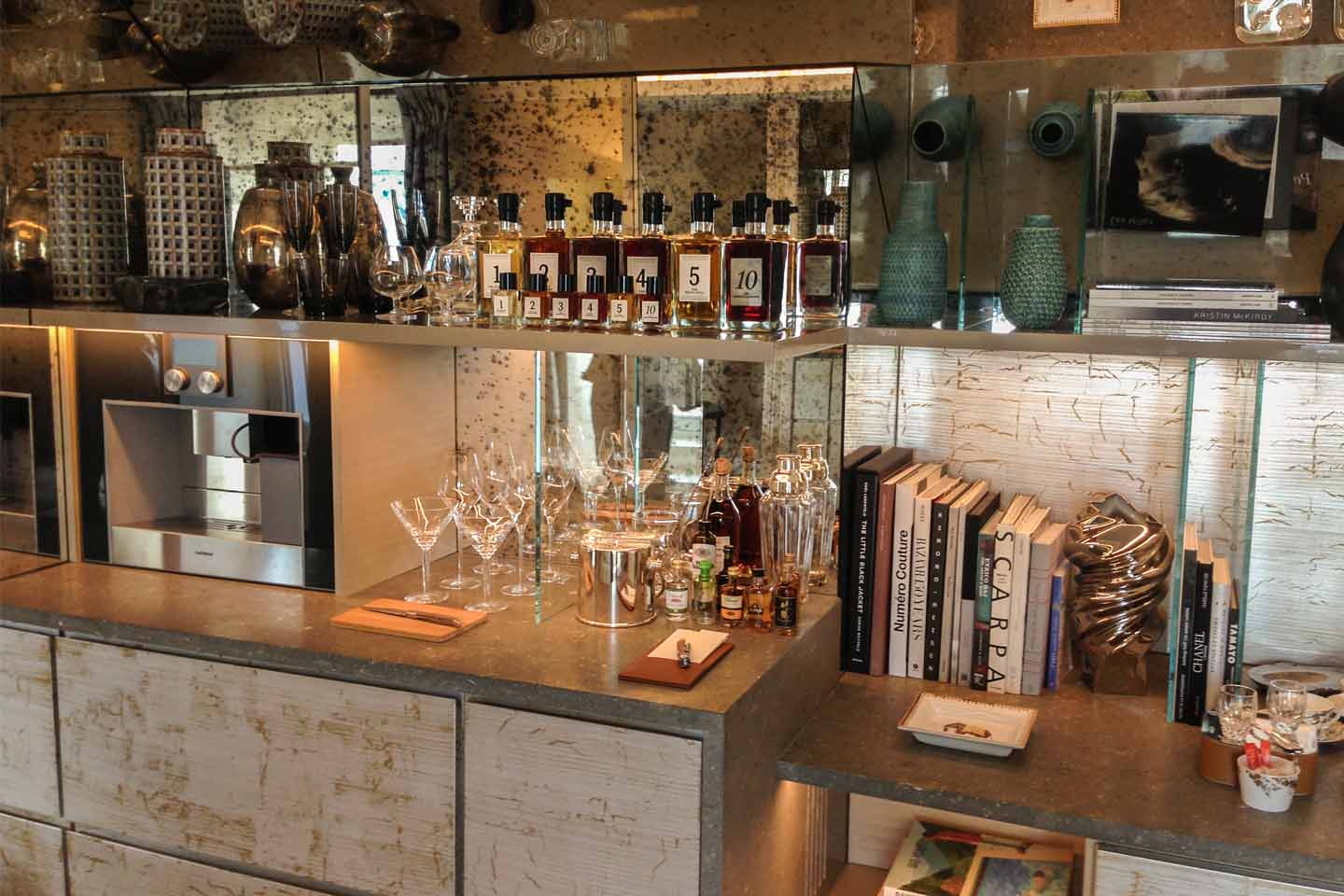
Luxury hotels and a ‘sense of place’: Brand identity and experiences
Apr 24, 2024

Luxury hotels and a ‘sense of place’: The branding imperative
Apr 17, 2024

Navigating challenges of AI and maximizing value in the service sector
Apr 16, 2024
The best step-up for a successful career in hospitality
Our Master's in Hospitality Management is an internationally recognized MSc qualification. You will have a choice of four academic routes: CSR & Sustainable Transformation, Finance, Real Estate & Consulting, Food & Beverage Management, or Luxury Experience Management. These routes enable you to specialize through your studies.
This is a title
This is a text
More articles
- Bachelor Degree in Hospitality
- Pre-University Courses
- Master’s Degrees & MBA Programs
- Executive Education
- Online Courses
- Swiss Professional Diplomas
- Culinary Certificates & Courses
- Fees & Scholarships
- Bachelor in Hospitality Admissions
- EHL Campus Lausanne
- EHL Campus (Singapore)
- EHL Campus Passugg
- Host an Event at EHL
- Contact our program advisors
- Join our Open Days
- Meet EHL Representatives Worldwide
- Chat with our students
- Why Study Hospitality?
- Careers in Hospitality
- Awards & Rankings
- EHL Network of Excellence
- Career Development Resources
- EHL Hospitality Business School
- Route de Berne 301 1000 Lausanne 25 Switzerland
- Accreditations & Memberships
- Privacy Policy
- Legal Terms
© 2024 EHL Holding SA, Switzerland. All rights reserved.
Travel, Tourism & Hospitality
Global tourism industry - statistics & facts
What are the leading global tourism destinations, digitalization of the global tourism industry, how important is sustainable tourism, key insights.
Detailed statistics
Total contribution of travel and tourism to GDP worldwide 2019-2033
Number of international tourist arrivals worldwide 1950-2023
Global leisure travel spend 2019-2022
Editor’s Picks Current statistics on this topic
Current statistics on this topic.
Leading global travel markets by travel and tourism contribution to GDP 2019-2022
Travel and tourism employment worldwide 2019-2033
Related topics
Recommended.
- Hotel industry worldwide
- Travel agency industry
- Sustainable tourism worldwide
- Travel and tourism in the U.S.
- Travel and tourism in Europe
Recommended statistics
- Basic Statistic Total contribution of travel and tourism to GDP worldwide 2019-2033
- Basic Statistic Travel and tourism: share of global GDP 2019-2033
- Basic Statistic Leading global travel markets by travel and tourism contribution to GDP 2019-2022
- Basic Statistic Global leisure travel spend 2019-2022
- Premium Statistic Global business travel spending 2001-2022
- Premium Statistic Number of international tourist arrivals worldwide 1950-2023
- Basic Statistic Number of international tourist arrivals worldwide 2005-2023, by region
- Basic Statistic Travel and tourism employment worldwide 2019-2033
Total contribution of travel and tourism to gross domestic product (GDP) worldwide in 2019 and 2022, with a forecast for 2023 and 2033 (in trillion U.S. dollars)
Travel and tourism: share of global GDP 2019-2033
Share of travel and tourism's total contribution to GDP worldwide in 2019 and 2022, with a forecast for 2023 and 2033
Total contribution of travel and tourism to GDP in leading travel markets worldwide in 2019 and 2022 (in billion U.S. dollars)
Leisure tourism spending worldwide from 2019 to 2022 (in billion U.S. dollars)
Global business travel spending 2001-2022
Expenditure of business tourists worldwide from 2001 to 2022 (in billion U.S. dollars)
Number of international tourist arrivals worldwide from 1950 to 2023 (in millions)
Number of international tourist arrivals worldwide 2005-2023, by region
Number of international tourist arrivals worldwide from 2005 to 2023, by region (in millions)
Number of travel and tourism jobs worldwide from 2019 to 2022, with a forecast for 2023 and 2033 (in millions)
- Premium Statistic Global hotel and resort industry market size worldwide 2013-2023
- Premium Statistic Most valuable hotel brands worldwide 2023, by brand value
- Basic Statistic Leading hotel companies worldwide 2023, by number of properties
- Premium Statistic Hotel openings worldwide 2021-2024
- Premium Statistic Hotel room openings worldwide 2021-2024
- Premium Statistic Countries with the most hotel construction projects in the pipeline worldwide 2022
Global hotel and resort industry market size worldwide 2013-2023
Market size of the hotel and resort industry worldwide from 2013 to 2022, with a forecast for 2023 (in trillion U.S. dollars)
Most valuable hotel brands worldwide 2023, by brand value
Leading hotel brands based on brand value worldwide in 2023 (in billion U.S. dollars)
Leading hotel companies worldwide 2023, by number of properties
Leading hotel companies worldwide as of June 2023, by number of properties
Hotel openings worldwide 2021-2024
Number of hotels opened worldwide from 2021 to 2022, with a forecast for 2023 and 2024
Hotel room openings worldwide 2021-2024
Number of hotel rooms opened worldwide from 2021 to 2022, with a forecast for 2023 and 2024
Countries with the most hotel construction projects in the pipeline worldwide 2022
Countries with the highest number of hotel construction projects in the pipeline worldwide as of Q4 2022
- Premium Statistic Airports with the most international air passenger traffic worldwide 2022
- Premium Statistic Market value of selected airlines worldwide 2023
- Premium Statistic Global passenger rail users forecast 2017-2027
- Premium Statistic Daily ridership of bus rapid transit systems worldwide by region 2023
- Premium Statistic Number of users of car rentals worldwide 2019-2028
- Premium Statistic Number of users in selected countries in the Car Rentals market in 2023
- Premium Statistic Carbon footprint of international tourism transport worldwide 2005-2030, by type
Airports with the most international air passenger traffic worldwide 2022
Leading airports for international air passenger traffic in 2022 (in million international passengers)
Market value of selected airlines worldwide 2023
Market value of selected airlines worldwide as of May 2023 (in billion U.S. dollars)
Global passenger rail users forecast 2017-2027
Worldwide number of passenger rail users from 2017 to 2022, with a forecast through 2027 (in billion users)
Daily ridership of bus rapid transit systems worldwide by region 2023
Number of daily passengers using bus rapid transit (BRT) systems as of April 2023, by region
Number of users of car rentals worldwide 2019-2028
Number of users of car rentals worldwide from 2019 to 2028 (in millions)
Number of users in selected countries in the Car Rentals market in 2023
Number of users in selected countries in the Car Rentals market in 2023 (in million)
Carbon footprint of international tourism transport worldwide 2005-2030, by type
Transport-related emissions from international tourist arrivals worldwide in 2005 and 2016, with a forecast for 2030, by mode of transport (in million metric tons of carbon dioxide)
Attractions
- Premium Statistic Leading museums by highest attendance worldwide 2019-2022
- Basic Statistic Most visited amusement and theme parks worldwide 2019-2022
- Basic Statistic Monuments on the UNESCO world heritage list 2023, by type
- Basic Statistic Selected countries with the most Michelin-starred restaurants worldwide 2023
Leading museums by highest attendance worldwide 2019-2022
Most visited museums worldwide from 2019 to 2022 (in millions)
Most visited amusement and theme parks worldwide 2019-2022
Leading amusement and theme parks worldwide from 2019 to 2022, by attendance (in millions)
Monuments on the UNESCO world heritage list 2023, by type
Number of monuments on the UNESCO world heritage list as of September 2023, by type
Selected countries with the most Michelin-starred restaurants worldwide 2023
Number of Michelin-starred restaurants in selected countries and territories worldwide as of July 2023
Online travel market
- Premium Statistic Online travel market size worldwide 2017-2028
- Premium Statistic Estimated desktop vs. mobile revenue of leading OTAs worldwide 2023
- Premium Statistic Number of aggregated downloads of leading online travel agency apps worldwide 2023
- Basic Statistic Market cap of leading online travel companies worldwide 2023
- Premium Statistic Estimated EV/Revenue ratio in the online travel market 2024, by segment
- Premium Statistic Estimated EV/EBITDA ratio in the online travel market 2024, by segment
Online travel market size worldwide 2017-2028
Online travel market size worldwide from 2017 to 2023, with a forecast until 2028 (in billion U.S. dollars)
Estimated desktop vs. mobile revenue of leading OTAs worldwide 2023
Estimated desktop vs. mobile revenue of leading online travel agencies (OTAs) worldwide in 2023 (in billion U.S. dollars)
Number of aggregated downloads of leading online travel agency apps worldwide 2023
Number of aggregated downloads of selected leading online travel agency apps worldwide in 2023 (in millions)
Market cap of leading online travel companies worldwide 2023
Market cap of leading online travel companies worldwide as of September 2023 (in million U.S. dollars)
Estimated EV/Revenue ratio in the online travel market 2024, by segment
Estimated enterprise value to revenue (EV/Revenue) ratio in the online travel market worldwide as of April 2024, by segment
Estimated EV/EBITDA ratio in the online travel market 2024, by segment
Estimated enterprise value to EBITDA (EV/EBITDA) ratio in the online travel market worldwide as of April 2024, by segment
Selected trends
- Premium Statistic Global travelers who believe in the importance of green travel 2023
- Premium Statistic Sustainable initiatives travelers would adopt worldwide 2022, by region
- Premium Statistic Airbnb revenue worldwide 2017-2023
- Premium Statistic Airbnb nights and experiences booked worldwide 2017-2023
- Premium Statistic Technologies global hotels plan to implement in the next three years 2022
- Premium Statistic Hotel technologies global consumers think would improve their future stay 2022
Global travelers who believe in the importance of green travel 2023
Share of travelers that believe sustainable travel is important worldwide in 2023
Sustainable initiatives travelers would adopt worldwide 2022, by region
Main sustainable initiatives travelers are willing to adopt worldwide in 2022, by region
Airbnb revenue worldwide 2017-2023
Revenue of Airbnb worldwide from 2017 to 2023 (in billion U.S. dollars)
Airbnb nights and experiences booked worldwide 2017-2023
Nights and experiences booked with Airbnb from 2017 to 2023 (in millions)
Technologies global hotels plan to implement in the next three years 2022
Technologies hotels are most likely to implement in the next three years worldwide as of 2022
Hotel technologies global consumers think would improve their future stay 2022
Must-have hotel technologies to create a more amazing stay in the future among travelers worldwide as of 2022
- Premium Statistic Travel and tourism revenue worldwide 2019-2028, by segment
- Premium Statistic Distribution of sales channels in the travel and tourism market worldwide 2018-2028
- Premium Statistic Inbound tourism visitor growth worldwide 2020-2025, by region
- Premium Statistic Outbound tourism visitor growth worldwide 2020-2025, by region
Travel and tourism revenue worldwide 2019-2028, by segment
Revenue of the global travel and tourism market from 2019 to 2028, by segment (in billion U.S. dollars)
Distribution of sales channels in the travel and tourism market worldwide 2018-2028
Revenue share of sales channels of the travel and tourism market worldwide from 2018 to 2028
Inbound tourism visitor growth worldwide 2020-2025, by region
Inbound tourism visitor growth worldwide from 2020 to 2022, with a forecast until 2025, by region
Outbound tourism visitor growth worldwide 2020-2025, by region
Outbound tourism visitor growth worldwide from 2020 to 2022, with a forecast until 2025, by region
Further reports Get the best reports to understand your industry
Get the best reports to understand your industry.
Mon - Fri, 9am - 6pm (EST)
Mon - Fri, 9am - 5pm (SGT)
Mon - Fri, 10:00am - 6:00pm (JST)
Mon - Fri, 9:30am - 5pm (GMT)

The Development of the Hotel and Tourism Industry in the Twentieth Century
Comparative Perspectives from Western Europe, 1900–1970
- © 2023
- Carlos Larrinaga 0 ,
- Donatella Strangio 1
Faculty of Economics and Business, University of Granada, Granada, Spain
You can also search for this editor in PubMed Google Scholar
Faculty of Economics, Sapienza University of Rome, Rome, Italy
- Fills a gap in the literature on the history of hotels by integrating wider economic and business implications
- Brings together comparative perspectives on the role of tourism in economic development in the 20th century
- Presents a detailed economic history of the growth of the hotel industry in Europe and its impact on tourism
Part of the book series: Palgrave Studies in Economic History (PEHS)
575 Accesses
This is a preview of subscription content, log in via an institution to check access.
Access this book
- Available as EPUB and PDF
- Read on any device
- Instant download
- Own it forever
- Durable hardcover edition
- Dispatched in 3 to 5 business days
- Free shipping worldwide - see info
Tax calculation will be finalised at checkout
Other ways to access
Licence this eBook for your library
Institutional subscriptions
Table of contents (13 chapters)
Front matter, introduction.
- Carlos Larrinaga, Donatella Strangio
The Hotel Industry in Mountain Tourism Development: Balancing the Profit Motive and the General Interest (Pyrenees, Late Nineteenth Century-1960s)
- Steve Hagimont
State Intervention in the Swiss Hospitality Industry: From the End of Laissez-Faire to the Beginnings of Neoliberalism (1915–1967)
- Mathieu Narindal
Tourism, Hotel Industry and Banking Development: The Case of the Lake Geneva Region at the Beginning of the Twentieth Century
- Cédric Humair
Demobilisation and the Postwar Hotel: Britain’s Release and Retention of Requisitioned Premises, 1918–1925
- Kevin J. James
Brittany Hotel Industry and Second World War: Total Crisis, Global Opportunism (1940–1952)
- Yves-Marie Evanno, Johan Vincent
A Grand Hôtel Between the Liberal Age and Fascism in Italy: Grand Hôtel du Vésuve in Naples
- Annunziata Berrino
Relations Between Companies and the State in the First Third of the Twentieth Century. The Case of the Hotel Industry
Carlos Larrinaga
The Hotel Offer in the Province of Malaga (Spain) Between 1900 and 1936
- Víctor M. Heredia, Marta Luque
The Hospitality Sector in Italy. Hotel Industry and Tourist Flows in Rome in the Interwar Period
- Donatella Strangio, Marco Teodori
The Origins of the Public Hotel Chain Paradores de Turismo de España , 1926–1936
- Carmelo Pellejero
Conclusions
Correction to: brittany hotel industry and second world war: total crisis, global opportunism (1940–1952), back matter.
- economic history of tourism
- wartime hotels
- Grand Hôtel du Vésuve
- Lake Geneva tourism history
- Second World War
- development of the hotel and tourism industry
- hospitality industry
- tourism growth
- hotel industry
- economy of hospitality
- mountain tourism

About this book
This edited collection explores the pivotal role of the hotel industry in building Western Europe’s tourism economy during the 20th century.
The book brings together ten contributions focused on the same period, 1900-1970, to offer comparative perspectives from across the region including Italy, Switzerland, France, Spain and Britain. Drawing on historical case studies, chapters illuminate the different factors linking hotels and the broader tourism system including interventions of the public authorities and the State, the importance of private involvement, commercial strategies, the medium-term development of private hotels, hotel entrepreneurship, and the impact of economic crises and wars. By placing differing national approaches taken to the growth of the hotel industry in comparison, the book aims to fill a gap in the historiography of European hospitality and shed light on the wider impact of hotels and tourism on economic development at both a national and regional level. It will be of interest to a range of scholars, including in economic and business history, tourism studies, the history of tourism management, and social history.
Editors and Affiliations
Donatella Strangio
About the editors
Carlos Larrinaga is Reader in Economic History at the University of Granada, Andalusia, Spain. His research is in the history of tourism, railways in the 19th century and the service sector. He has undertaken research in several stays at Bordeaux-Montaigne University and at Aberystwyth University. He leads the project ‘Tourism in Spain in the first third of the 20th century: characteristics and evolution of an economic activity and a social practice in comparative perspective’, funded by the Ministry of Science and Innovation of the Government of Spain and European Regional Development Fund.
Donatella Strangio is Full Professor of Economic History at Sapienza University of Rome, Italy. She has been Director of Masters program in Business Management at Sapienza University of Rome. She is a researcher of the project ‘Tourism in Spain in the first third of the 20th century: characteristics and evolution of an economic activity and a social practice in comparative perspective’, funded by the Ministry of Science and Innovation of the Government of Spain and European Regional Development Fund.
Bibliographic Information
Book Title : The Development of the Hotel and Tourism Industry in the Twentieth Century
Book Subtitle : Comparative Perspectives from Western Europe, 1900–1970
Editors : Carlos Larrinaga, Donatella Strangio
Series Title : Palgrave Studies in Economic History
DOI : https://doi.org/10.1007/978-3-031-45889-7
Publisher : Palgrave Macmillan Cham
eBook Packages : Economics and Finance , Economics and Finance (R0)
Copyright Information : The Editor(s) (if applicable) and The Author(s), under exclusive license to Springer Nature Switzerland AG 2023
Hardcover ISBN : 978-3-031-45888-0 Published: 21 December 2023
Softcover ISBN : 978-3-031-45891-0 Due: 22 June 2024
eBook ISBN : 978-3-031-45889-7 Published: 20 December 2023
Series ISSN : 2662-6497
Series E-ISSN : 2662-6500
Edition Number : 1
Number of Pages : XI, 222
Number of Illustrations : 6 b/w illustrations, 3 illustrations in colour
Topics : Economic History , Tourism Management , European History , Social History
- Publish with us
Policies and ethics
- Find a journal
- Track your research
CONTACT INFO
RUSSELL AND DAWSON – AN ARCHITECTURE AND ENGINEERING FIRM
D-U-N-S® Number: 118458117

Evolution of Hospitality Industry
In the year 1980, the United Nations World Tourism Organization announced the day of September 27 as “World Tourism Day”. The idea of this celebration is to bring sustainability to the tourism sector all around the world. UN World Tourism Organization defines tourism as “Activities of persons traveling to and staying in different places for not more than a consecutive year for leisure, business or traveling purpose.” The inception of traveling is as old as mankind. Our ancient civilizations travelled great lengths in search of food and shelter. Over the period of time, the purpose of traveling changed. The mere act of traveling has now become a giant industry. The tourism industry is a collage of various services like transportation, food, and beverages, lodging, travel agencies, entertainment, etc… Back in the old times, land and water were the only means of transportation. And they were often considered risky. But as the innovations gave birth to more convenient and safer ways of transportation, the tourism industry saw humongous growth in the number of travelers all around the globe. The tourism industry that we see today is the product of evolution in the hospitality sector, Innovations in transportations, advancements in communication technology, etc.
The idea of hospitality is what lies in the center of the tourism industry. The term Hospitality has been derived from a French word “Hospice” which means “Taking care of the travelers”. In Old times, locals used to let the travelers rest on kitchen floors or other extra spaces during their journey. There were no purpose-built resting facilities for tourists until monasteries decided to build one. This gave birth to lodging services. In the late 1700s, Inns came into being. Inns were nothing but a shelter by the road where travelers can stop to take rest and get some food. They would also take care of traveler’s horses while they rest. This is the time when the seeds of the modern hospitality facility were planted. What we see today is the growth of the past two millennia. Here’s how the lodging facilities evolved with time.
19TH CENTURY: INDULGENCE OF LUXURY INTO THE EVOLUTION OF HOSPITALITY INDUSTRY
In the early 1800s, “Inns” were the only lodging facility available for the tourists. A lot of Inns were established prior 19th century. But, lodging was not just about bedding and resting facility anymore. They started providing food and drinks to the travelers. And soon the element of luxury started to blend in. This gave birth to hotels. Hotels emerged as more sophisticated facilities which provided better rooms and dining areas. The year of 1829 is considered as a landmark in the timeline of the American hospitality industry. It was the year when an American architect Isaiah Rogers designed and constructed the first luxury hotel “Tremont Hotel” in Boston, Massachusetts. It was the first hotel with private attached bathroom and lock on the doors. It used a steam-powered pump to lift up water to the storage tank on the roof. “Tremont Hotel” had set a benchmark for the luxurious hotels in those days. The hotels and Inns then on started giving more importance to services to stand out different than other hotels. They kept improving their services and facilities. At the later stage, hotels started to have bars. And soon the bars became an important selling point for the hotels. The architecture and aesthetics of the hotels were improving alongside. There were more multistory hotels and they had the beautiful exterior to stand out different from other hotels. Soon it was a trend for well-decorated ceilings and beautiful crystal chandeliers.
20TH CENTURY: BEGINNING OF MODERN HOSPITALITY ERA
Hospitality, which was rather a part of the culture, emerged as a huge business opportunity. A lot of people are approaching Architectural Design Firm to change the Hotel Design Architecture by incorporating more and more facilities. Innovations in transportation systems enabled more and more people to travel. Some people saw the opportunity and jumped into the hotel business. That is why in the early to mid 20th Century, a lot of giant hotel chains started doing their business. The industry had become more competitive than ever. In the year 1919, Conard Hilton opened his first hotel in Texas. Later on, Conard also bought the Ellsworth Statler’s chain of hotels in the year 1954. Marriot (est. 1927), Sheraton (est. 1937) and Hyatt (est. in 1957) also emerged as giant players in the industry.
There is an interesting story behind why Kemmon Wilson started Holiday Inn series of hotels and inns. Once Kemmon Wilson had gone for a holiday to Washington DC with his family. He had to pay extra for his five children in all the hotels they stayed in. Kemmon found the accommodations very expensive and uncomfortable for families. So he decided to start his own hotel. That is how the first Holiday Inn started in the year 1952. Holiday Inn went on to set better hospitality standards. Their main focus was to build family-friendly hotels. With their first hotel built in 1952, Holiday group went on to build its 1000th Holiday Inn in the year 1968. It was indeed a phenomenal growth for any hotel brand in those days.

Cars became extremely popular in the mid 20th century. Intercity traveling became more convenient because of the well-connected network of roads. These factors favored the growth of Motels. The word motel is made up of “Motor and Hotel”. Motels were small 10×10 Ft wooden cabins for the travelers to take rest during the night journeys. These motels were built alongside the main highways to host more and more people who might want to take rest for a few hours or stay overnight during their journey. The concept of the motel was well received and they grew exponentially in numbers in a later stage. The motels were affordable and convenient and that is the reason why the concept of Motels was well received.
21ST CENTURY: TECHNOLOGICAL INTEGRATIONS IN THE EVOLUTION OF HOSPITALITY INDUSTRY
While it all started with providing only a place for sleeping, the traditional hospitality industry has evolved to become what we see today. Despite all the changes the industry saw, the customer has always been the center. It is consistently evolving to become more advanced. In this new century, the hotels reached the new heights, literally. Some of the tallest hotels were built in the 21st century. The technological advancements in the Engineering Design Services made it all possible. Hotel Fairmont Makkah and Burj al Arab are some examples of it.
Founded in the year 2008, Airbnb opened up a new segment in the hospitality industry. It acts as a marketplace connecting people who wanted to rent their property with those who want to rent it. Since more and more people are traveling for business or for leisure, this gives them a very convenient and affordable option. Also, there has been seen a great hike in the number of solo travellers globally. These solo travellers not much bothered about the amenities. They don’t mind sharing spaces. They love meeting and interacting with locals as well as fellow travellers. And that is why concepts of youth hostels and home-hospitality have become new trends. The Internet helps a lot to such hospitality businesses. People can see the availability, photos, and reviews from other users. Today, we can browse through all our possible option for staying in any part of the world. We can know about services and amenities. Not only we can reserve our stay but we can also pay in advance. The recent trends in the evolution of hospitality industry favor the construction of hotels which has a classic historic touch integrated with modern services.

The hotel industry has always contributed largely in terms of revenue for any healthy economy. The modern hotel industry in 1960 valued around $3 Billion, which crossed the mark of $25 Billion in the year 1990. These numbers went down due to attacks of 9/11 and recession in the early 2000s. But the industry and its people stood strong and got back its lost pace soon in the new decade. Today, the hotel industry is worth more than $500 Billion providing jobs to 4.5 million people.
We at Russell and Dawson feel extremely proud of being associated with the hospitality industry. Founded in the year 1965, Russell and Dawson is a client-first company which has been providing architecture, engineering and construction services nationally and internationally for more than 50 years now. From the first hospitality project in the year 1982, we have provided various services to more than 245+ hospitality projects so far. Russell and Dawson has worked with hotel developers/owners for the new development, conversion or renovation projects for prestigious brands like IHG (40+ projects), Marriott (45+ projects), Hilton (65+ projects), Carlson Group (4 Projects), Best Western (15+ projects), Hyatt and independent brands in the northeast region and overseas – India, UAE (Dubai), Sri Lanka, Egypt, Bahrain, and Brunei.
Since 1965, Russell and Dawson have been meeting and exceeding the expectations of our clients. If you would like to learn more about the incredible benefits of our hotel design-build service and connect with architectural experts regarding your next construction project, please call or contact us online today!
Related Posts

Architectural Design & Engineering services since 1965

5 stages of Architectural Design Process

Architecture, Design & Construction trends in 2018

News & Events
Stay up-to-date with gecko hospitality., the evolution of hospitality: from ancient traditions to modern day experiences and the many innovations along the way.
- Robert Krzak
- January 13, 2023
There is a deep and rich history in this industry of ours. In fact, the concept of hospitality is extremely old and is mentioned in writings dating back to Ancient Greece and Rome. The thought then was that hospitality to strangers was necessary to their religious well-being and in others. Some also believed that being hospitable would satisfy their own superstitious fears. Whatever the reasons, the roots of hospitality run deep.
In the Beginning
Hospitality as a business dates back to 15,000 B.C.. This was the first documented instance of one tribe hosting another at the Lascaux caves in France. The word hospitality comes from the Latin “hospitalitas” which means to receive as a guest. In ancient times, it meant extending a welcome to travelers or offering a home away from home. Eventually evolving to the days of taverns and innkeepers, hospitality is one of the oldest businesses. But it’s a business that started as an act of kindness.
In the early days, locals used to let travelers rest on kitchen floors or other extra spaces during their journey. There were no purpose-built resting facilities for tourists until monasteries decided to build one. This eventually gave birth to lodging services and by the 1700s, inns came into being. Proprietors would put up a shelter by the road where travelers could stop to take rest and get some food. They would also take care of traveler’s horses while the patrons rested.
The Introduction of Leisure Tourism
But our modern form of the hospitality industry dates back to the early 1800s. This is when the concept of leisure tourism spread across Europe, bringing a multitude of wealthy travelers to Switzerland. During that time, visitors sought natural exposure on guided tours in the Swiss Alps, train rides and “wellness tourism,” Elegant hotels, ski resorts, and thermal baths became icons of luxury tourism.
This leisure tourism opened a new world of services like transportation, food and beverages, lodging, travel agencies, entertainment and more. It was this collage of services that eventually become known as the hospitality industry. Business travel began to dominate the industry, but leisure travel became more and more popular. From the early 1900s through the 1950s, disposal income gave rise to a greater desire to travel.

A Time of Luxury and Service
Then came the Golden Age of hospitality. This was between 1960 through 1980 and was where organizational culture and value creation were driven by luxury and service. In post WWII, wealth for many Americans was increasing. This meant more money to spend on luxury goods and travel.
It was a time when Sheraton purchased the St. Regis New York to bulk up its luxury division in 1960. It’s also when Isadore Sharp founded the Four Seasons Hotels in 1961. His vision was to found a company on his Golden Rule: “ Treat guests the way you wish to be treated .” During this period, Ritz Carlton was founded and carved out its own niche in this segment.
The hospitality leaders of this era were experts in customer service and hospitality business operations. London had its Savoy Hotel and New York had Delmonico. These created stellar luxury and service standards. As more properties got into the luxury game, more visitors demanded more luxury. Each property tried to outdo the other in attempts to attract high net worth guests.
The Segmentation of Markets
Through around 1980 and 2000, the hospitality market began to focus on targeting very specific customers. During this time, people like Chip Conley (Joie de Vivre) and Ian Shrager (Morgans Hotels) focused on unique and differentiated offerings. This led to the design-led boutique hotel. During this time period, through some careful maneuvering and creative financing, Barry Sternlicht buys Sheraton.
To segment his properties and laser-focus on a specific customer group, Sternlicht creates W Hotel. He grows the W brand to more than 13,000 rooms globally and almost 8,000 in the development pipeline. The segmentation of markets continues today with boutique hotels spinning off from corporate conglomerates (Hilton, Marriott, Sheraton).
Digitizing of the Hospitality Industry
Finally, from around 1995 to present, digitizing and new technologies are transforming the hospitality industry. In 1996, Microsoft founded Expedia allowing travelers to make room reservations via a computer. Today Expedia and Priceline dominate the reservations market with a 94% share. The industry has come a long way from having to contact the hotel to make reservations. It’s now done through companies that even own a hotel property.

This is about the same time that AirBnB took the concept of couch surfing to a whole new level. These properties, mostly privately owned, attracted millions who wanted the space and privacy short-term rentals provide. Renting a vacation home dates back to the 1950s. But now, sites like VRBO and Booking.com allow users to book vacation rental properties managed by individual owners.
Where We Are Now
Hospitality is now one of the largest and diverse industries in the world. In some countries and states, it is the largest employer with hundreds of millions employees. It has grown and continues to grow by adding new segments of industry support along the way. The hospitality industry has expanded to almost everything that can support the traveler’s needs. Today, businesses in the industry can generally be divided into four categories:
- Food & Beverage
- Travel & Tourism
Under each of these categories are sub-sectors that also continue to expand. For example, under travel and tourism is Ubers, virtual reality, and space tourism. All categories and sub-sectors are interconnected, but each face their own challenges. But they also open their own world of opportunities.
Improving But Staying the Same
Technology has played an important role in the hospitality and tourism industry over the past decade. It helps reduce costs, enhance operational efficiency, and improve services and customer experience. Technology also facilitates easy connection and communication across borders and continents. It helps the hospitality industry in terms of higher number of bookings and easier communication with the customers.
The hospitality industry has evolved using newer technologies that include:
- Voice search and control -Includes everything from using smart speakers in hotel rooms, and allowing for control of the various in-room devices.
- Contactless payments -Offers several advantages for hotels, resorts, restaurants, bars, and cafes.
- Chatbots -A good chatbot will answer the most common questions without requiring human involvement.
- Virtual reality -Gives potential customers a much clearer sense of what they can expect when they visit.
- Recognition technology -This is where biometrics is used to for seamless authentications, benefitting hotel processes and customer purchases.
- Artificial intelligence -Allows customers to interact with hospitality companies across a variety of digital channels and receive rapid responses.
- WiFi 6 -The next generation of WiFi technology. It is more than 30% faster while also boasting significantly improved throughput.
- Robots -Can occupy a concierge role within hotels, welcoming guests and providing them with important customer information. Can also serve in cleaning roles such as vacuuming floors and germ-killing.
Improvement in roads, cars, trains, and planes makes it easier for travelers to reach their destinations. Additionally, technology has helped to make it easier to book a room, order food, and access other amenities. But the hospitality industry succeeds based on the foundational principles of its origin and not more advanced technologies.
Succeeding in Hospitality
The Princeton definition for hospitality is, “ entertainment of guests or strangers without reward or with kind and generous liberality .” Many hospitality businesses would not survive today without reward of some kind, but the human-centered philosophy remains the same. Going forward, the challenge for providers will be to keep alive the human touch that has made hospitality establishments successful. At the same time, adapting to and using these new technologies will be crucial in the fight for customers.
In the end, it’s not about the tools used to provide the service. It’s the product, not the technology, that defines the guest experience. Guests remember not just the standard of service but the extraordinary hospitality that makes them feel welcome and appreciated. Gadgets and gizmos are there to assist in providing continual excellent service. As the hospitality industry continues to evolve, hospitality businesses that succeed will be those that focus on the guest experience.

- Tags: Evolution of the Hospitality Industry , History of Hospitality , Hospitality Industry
Sign up for the latest News and Insights
- Career Advice
- Club Management
- Gecko Hospitality
- Hiring Advice
- Hospitality Leadership
- Job Search Tips
- Management Tips
- White Papers
Corporate Office
- 13379 McGregor Blvd Suite #1 Fort Myers, Florida 33919
- 239-690-7006
- Franchise Info

Explore Jobs
- Jobs Near Me
- Remote Jobs
- Full Time Jobs
- Part Time Jobs
- Entry Level Jobs
- Work From Home Jobs
Find Specific Jobs
- $15 Per Hour Jobs
- $20 Per Hour Jobs
- Hiring Immediately Jobs
- High School Jobs
- H1b Visa Jobs
Explore Careers
- Business And Financial
- Architecture And Engineering
- Computer And Mathematical
Explore Professions
- What They Do
- Certifications
- Demographics
Best Companies
- Health Care
- Fortune 500
Explore Companies
- CEO And Executies
- Resume Builder
- Career Advice
- Explore Majors
- Questions And Answers
- Interview Questions
25 Hotel Industry Statistics [2023]: Hotel Rate Trends And Market Data

- Wedding Industry Statistics
- Yoga Industry Statistics
- Music Industry Statistics
- Landscaping Industry Statistics
- Bicycle Industry Statistics
- Coffee Industry Statistics
- Car Rental Industry Statistics
- Home Improvement Industry Statistics
- Insurance Industry Statistics
- Supplements Industry Statistics
- Golf Industry Statistics
- Fitness Industry Statistics
- US Media And Entertainment Industry Statistics
- Firearm Industry Statistics
- Financial Services Industry Statistics
- Health And Wellness Industry Statistics
- Trucking Industry Statistics
- Wine Industry Statistics
- Pet Industry Statistics
- Mobile App Industry Statistics
- Digital Marketing Industry Statistics
- Hotel Industry Statistics
- Retail Statistics
- Robotics Industry Statistics
- Jewelry Industry Statistics
- Appointment Scheduling statistics
- Restaurant Industry Statistics
- Food Delivery Statistics
- Food Truck Industry
- Fashion Industry
- Real Estate Industry
- US Film Industry
- US Beverage Industry
- USu202fFast Food Restaurants
- US Construction Industry
- US Book Industry
- Cosmetics Industry
- US Food Retail Industry
- US Pharmaceutical Industry
- US Healthcare Industry
- Airline Industry
- Automobile Industry
- Transportation Industry Statistics
- Event Industry Statistics
- Project Management Statistics
- Oil And Gas Industry Statistics
- Nursing Home Statistics
- Nursing Shortage Statistics
- Nursing Statistics
Research Summary. The hotel industry not only reaches across the globe but also spans a wide cross-section of options ranging from budget motels to luxury resorts, making it an interesting field to study. Here are the key statistics on the hotel industry:
There are at least 187,000 hotels in the world as of 2023.
There are an estimated 17.5 million guestrooms in the world.
The global hospitality industry is worth over $4.548 trillion as of 2022.
There are about 1.6 million people employed by the U.S.’s accommodation industry.
The global travel and tourism industry was worth $4.671 trillion in 2020 , down from its $9.17 trillion value in 2019.
The average U.S. hotel occupancy rate is 64.2% as of February 2023.

Hotel Industry Statistics by Consumer Preferences
78% of millennials would rather spend their money on experiences than on things.
Hotels with a significant number of high-quality photos on their websites see a 15% increase in conversion rates.
This is compared to hotels that use few and/or low-quality photos. Including good photos of hotel rooms and amenities helps travelers know what they’re getting into and better imagine themselves there.
TripAdvisor shared that the number of photos a hotel has on its TripAdvisor profile has the most impact on traveler engagement with the listing.
More specifically, properties with at least one photo see a 138% increase in engagement and are 225% more likely to receive a booking inquiry, and those with over 100 photos see a 151% increase in engagement and are 283% more likely to receive a booking inquiry.
Europe has the highest hotel occupancy rate of any region in the world.
As of 2019, European hotels have an occupancy rate of 72.2%, meaning an average of 72.2% of all hotel rooms are occupied.
US Hotel Industry Statistics
There are 90,562 hotel and motel businesses in the U.S.
This number is a 0.4% increase from 2021, which is on trend with the average annual growth rate of 0.4% that this industry has seen from 2017 to 2022.

There are approximately 5.29 million hotel rooms in the U.S.
The U.S. hotel and motel industry is worth $177.6 billion.
This industry is predicted to grow by 33.6% throughout 2022 as it continues to recover from the COVID-19 pandemic, although it’s seen an average annual decline of 2.4% from 2017 to 2022.
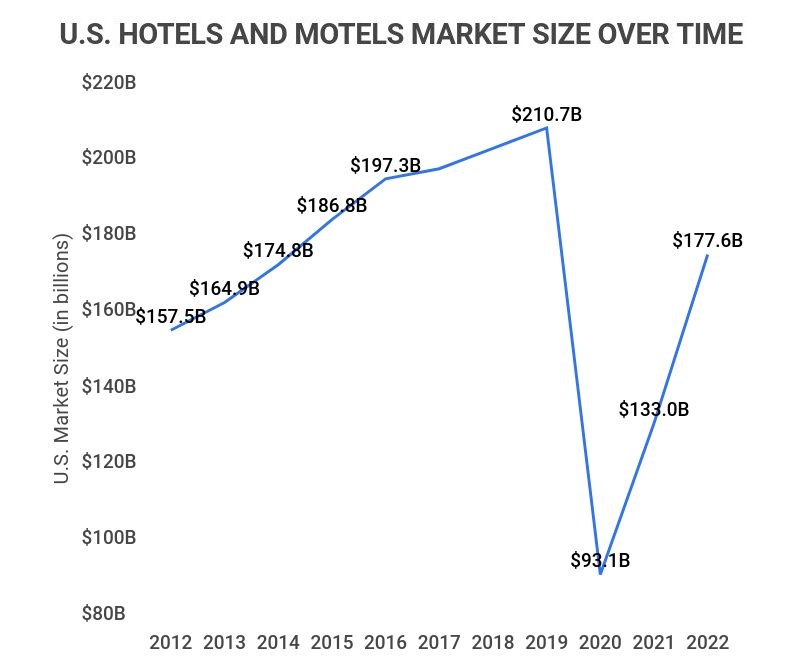
The U.S. tourism industry was valued at $545.11 billion in 2020.
In 2020, U.S. hotels had an average occupancy rate of 44%.
Hotel Industry Statistics by Employment
The U.S.’s accommodation industry employs about 1.6 million people.
In Q1 2019, there were 1.352 million gross job gains in the U.S. leisure and hospitality sector.
Here are data points for each quarter from Q1 2019 through Q2 2021.
In Q1 of 2019, there were 1.22 million gross job losses in the U.S. leisure and hospitality industry.
Here are the numbers for each quarter following that through Q2 2021:
The average employee of the U.S. leisure and hospitality industry makes $19.44 an hour.
32% of U.S. leisure and hospitality industry employees have access to employer-sponsored health care.
43% get paid vacation from their employers, and 50% receive paid sick leave .
Hotel Industry Trends and Projections
In 2019, the global hotels and resorts market was worth over $1.5 trillion.
This was just before the COVID-19 pandemic caused widespread lockdowns in 2020, and it was the pinnacle of seven years of nearly continuous growth.
From 2021 to 2025, the global hotel and travel accommodation industry is projected to have a CAGR of 7%.
This will result in a market value of $1.05 trillion in 2025. In 2020, the global hotel and travel accommodation market was worth $673.02 billion, and it grew to $801.9 billion in 2021, which is a CAGR of 19.1%.
In 2020, travel and tourism contributed $4.671 trillion to the global GDP.
While this is a significant amount of money, it is also a significant decrease from the $9.17 trillion it contributed in 2019. This is a result of the 2020 COVID-19 lockdowns that significantly reduced the amount of travel in the world.

From 2008 to 2018, the number of hotels around the world has increased by nearly 14,300.

Hotel Industry Statistics FAQ
What is the growth rate of the hotel industry?
The growth rate of the hotel industry is 19.1%. This was the CAGR from 2020 to 2021 as the global hotel industry reopened after the COVID-19 pandemic lockdowns began to lift.
What are the four segments of the hospitality industry?
The four segments of the hospitality industry are Food and Beverage, Accommodation (also referred to as Lodging), Travel and Tourism, and Entertainment and Recreation.
You don’t necessarily have to be traveling to enjoy the hospitality industry’s offerings. The Food and Beverage sector, for example, includes restaurants , bowling alley food, and concessions stands, not just hotel restaurants. As a result, this is the largest sector of the hospitality industry.
The Accommodation or Lodging sector includes hotels, campgrounds, rental homes, and any other facility that gives people a place to sleep. This includes resorts, motels, and hostels all alike.
The Travel and Tourism sector covers the actual act of traveling via airlines, cruise ships, trains, taxis, and more. Whether you’re traveling for leisure or business, chances are you’ll utilize at least one of travel and tourism’s offerings on a trip.
The last sector of the hospitality industry is Entertainment and Recreation. This sector is made up of all the activities that people do just for the enjoyment of it. These include:
Swimming pools
Spectator sports
Movie theaters
Participatory sports (e.g., scuba diving, golf, tennis)
Amusement parks
How many American hospitality workers were fired or laid off in 2020?
10.65 million American hospitality workers were fired or laid off in 2020. While About 1.2 to 1.4 million people in this industry lost their jobs each quarter throughout 2019, 1.695 found themselves unemployed in Q1 2020, and a whopping 6.331 million were suddenly unemployed in Q2 2020 due to the COVID-19 pandemic lockdowns.
Is the hotel industry recovering?
Yes, the hotel industry is recovering. The global hotel and travel accommodation industry is expected to have a CAGR of 7% from 2021 to 2025.
What are the latest trends in the hotel industry?
The latest trends in the hotel industry are high-tech, green facilities, alternative accommodation options, and incorporating experiences into hotel stays.
Hotels are beginning to implement more and more smart technology, whether it’s a keyless entry or turning on the AC with an app. In addition, many hotels are looking for ways to reduce their carbon footprint by conserving water, reducing single-use plastics, and earning their LEED certifications.
Another hotel industry trend is that travelers (especially millennials) are looking more toward alternative accommodation options, whether that’s a rental house or villa, a mobile home, or hotels with a personality that reflect the local culture rather than standardized branding.
Hotels are responding to this by focusing on opening boutique hotels and facilities that bring unique elements to their decor, amenities, and even floor plans.
The hotel industry is a major player in the global and U.S. economies. In 2022, the global hotel industry was worth more than $4.548 trillion and is projected to see a CAGR of 7% from 2021 to 2025. In the U.S. alone, the hotel and motel industry is worth $177.6 billion, and the tourism industry is worth $545.11 billion.
Lockdowns in response to the COVID-19 pandemic in 2020 significantly impacted this industry. The worldwide travel and tourism industry contributed $4.671 trillion to the global GDP in 2020, which is just over half the amount it contributed in 2019 ($9.17 trillion).
In the U.S., over seven million leisure and hospitality industry employees lost their jobs during the first six months of 2020, compared to the just over five million that found themselves unemployed throughout all of 2019. Hotel occupancy rates also dropped by 33.3% from 2019 to 2020.
Eventbrite. “ Millennials: Fueling the Experience Economy. ” Accessed on February 16, 2022.
Medium . “ The Importance of Imagery on Hotel Websites. ” Accessed on February 16, 2022.
Frederic Gonzalo. “ Photos Impact Bookings More Than Reviews. ” Accessed on February 16, 2022.
Statista. “ Occupancy Rate of the Hotel Industry Worldwide From 2008 to 2019, by Region. ” Accessed on February 16, 2022.
IBISWorld. “ Hotels & Motels in the U.S. – Number of Businesses 2005-2027. ” Accessed on February 16, 2022.
Statista. “ Number of Hotel Rooms in the United States From 2017 to 2020, by Chain Scale Segment. ” Accessed on February 16, 2022.
IBISWorld. “ Hotels & Motels in the U.S. – Market Size 2005-2027. ” Accessed on February 16, 2022.
Statista. “ Market Size of the Tourism Sector in the United States From 2011 to 2020, with a Forecast for 2021. ” Accessed on February 16, 2022.
Statista. “ Occupancy Rate of Hotel Industry in the United States From 2001 to 2020. ” Accessed on February 16, 2022.
U.S. Bureau of Labor Statistics. “ Accommodation: NAICS 721. ” Accessed on February 16, 2022.
U.S. Bureau of Labor Statistics. “ Economic News Release: Employment Situation Summary. ” Accessed on February 16, 2022.
U.S. Bureau of Labor Statistics. “ Databases, Tables & Calculators by Subject: Gross Job Gains for the Leisure and Hospitality Sector in the U.S. (Rounded to the Nearest Thousands.) ” Accessed on February 16, 2022.
U.S. Bureau of Labor Statistics. “ Databases, Tables & Calculators by Subject: Gross Job Losses for the Leisure and Hospitality Sector in the U.S. (Rounded to the Nearest Thousands). ” Accessed on February 16, 2022.
U.S. Bureau of Labor Statistics. “ Leisure and Hospitality. ” Accessed on February 16, 2022.
IBISWorld. “ Global Hotels & Resorts – Market Size 2005-2027. ” Accessed on February 16, 2022.
Globe Newswire. “ Global Hotel and Other Travel Accommodation Market Report 2021: Market is Expected to Grow From $673.02 Billion in 2020 to $801.9 Billion in 2021 – Long-term Forecast to 2025 & 2030. ” Accessed on February 16, 2022.
Statista. “ Total Contribution of Travel and Tourism to Gross Domestic Product (GDP) Worldwide From 2006 to 2020. ” Accessed on February 16, 2022.
Statista. “ Total Number of Hotels Worldwide From 2008 to 2018. ” Accessed on February 16, 2022.
Hospitality Net. “ What Are the 4 Segments of the Hospitality Industry. ” Accessed on February 16, 2022.
Hotel Tech Report. “ 100 Hotel Trends You Need To Watch in 2022 & Beyond. ” Accessed on February 16, 2022.
How useful was this post?
Click on a star to rate it!
Average rating / 5. Vote count:
No votes so far! Be the first to rate this post.

Abby is a writer who is passionate about the power of story. Whether it’s communicating complicated topics in a clear way or helping readers connect with another person or place from the comfort of their couch. Abby attended Oral Roberts University in Tulsa, Oklahoma, where she earned a degree in writing with concentrations in journalism and business.
Recent Job Searches
- Registered Nurse Jobs Resume Location
- Truck Driver Jobs Resume Location
- Call Center Representative Jobs Resume Location
- Customer Service Representative Jobs Resume
- Delivery Driver Jobs Resume Location
- Warehouse Worker Jobs Resume Location
- Account Executive Jobs Resume Location
- Sales Associate Jobs Resume Location
- Licensed Practical Nurse Jobs Resume Location
- Company Driver Jobs Resume
Related posts

30+ Invaluable Customer Loyalty Statistics [2023]: What Makes Customers Come Back?

25 Trending Cell Phones In The Workplace Statistics [2023]: Cell Phone Use And Distraction In The Workplace

23 Appointment Scheduling Statistics [2023]: Online Booking Trends

26 Average Salary Increase When Changing Jobs Statistics [2023]
- Career Advice >
- Industry Statistics >
To read this content please select one of the options below:
Please note you do not have access to teaching notes, the development of the tourism and hospitality industry.
Modeling Economic Growth in Contemporary Belarus
ISBN : 978-1-83867-696-4 , eISBN : 978-1-83867-695-7
Publication date: 8 November 2019
The development of the tourism and hospitality industry in Belarus has a long-term positive trend. This process is uneven and the growth rate is below the global average. To stimulate the development of the tourism and hospitality industry, measures are being taken in the form of creating visa-free zones, stimulating business activity, holding major sport events. The potential for growth in this industry has not yet been exhausted. The assessment of the competitiveness of Belarus in comparison with the neighboring countries showed that the development of the tourism and hospitality industry requires improvement of the business environment, increase of openness for tourists, strengthening of country marketing in the world tourism market.
- Tourism business
- Hospitality industry
- Destination
- Tourism competitiveness
- Tourism industry
- Accommodation sector
- Hotels and similar accommodation facilities
Tarasionak, A.I. and Dziadok, V.M. (2019), "The Development of the Tourism and Hospitality Industry", Sergi, B.S. (Ed.) Modeling Economic Growth in Contemporary Belarus ( Entrepreneurship and Global Economic Growth ), Emerald Publishing Limited, Leeds, pp. 163-180. https://doi.org/10.1108/978-1-83867-695-720191011
Emerald Publishing Limited
Copyright © 2020 Emerald Publishing Limited
We’re listening — tell us what you think
Something didn’t work….
Report bugs here
All feedback is valuable
Please share your general feedback
Join us on our journey
Platform update page.
Visit emeraldpublishing.com/platformupdate to discover the latest news and updates
Questions & More Information
Answers to the most commonly asked questions here

UN Tourism and Hotelschool The Hague to drive innovation in hospitality

UN Tourism and Hotelschool The Hague, have agreed to partner around the development and execution of pioneering projects in the hospitality industry.
A new Memorandum of Understanding (MoU) aims to stimulate innovation and fresh ventures within the hospitality industry, promoting entrepreneurship and education while engaging in open innovation projects that can enhance the tourism industry, with a particular focus on hospitality. Currently, 20% of entrepreneurs of the UN Tourism Network are directly related to hospitality and are the most dynamic projects including a variety of stakeholders of the industry.
Building on the UN Tourism’s established innovation network, this agreement will further facilitate connections between startups and potential investors, as well as promote knowledge and skills through joint events, communication channels, and media interactions. This partnership not only underlines a commitment to a more sustainable future for the industry but also signifies a shared commitment to providing inclusive opportunities and memorable global student experiences, demonstrated through Hotelschool The Hague’s global Sustainable Hospitality Challenge.
Strong foundations for innovative future
Ms. Natalia Bayona, Executive Director of UN Tourism, expresses: “Unfortunately 90% of startups within the hospitality sector eventually do not succeed. A decent tourism education and knowledge of the hospitality sector is necessary to develop a disruptive and well-functioning product. Through our collaborative efforts, we aspire to alter this trajectory by offering a more robust foundation, fostering invaluable connections, and providing a conducive testbed for emerging startups. Given that technology now permeates 70% of tourism enterprises, it is imperative that these startups are seamlessly integrated into the ecosystem, connected with pertinent stakeholders, and afforded the opportunity to validate their solutions in real-world settings before embarking on a larger scale.

Ms. Regine von Stieglitz, President of the Board of Directors of Hotelschool The Hague says: “At Hotelschool The Hague, we provide our students with the perfect balance of theory, real-world experience and applied research to prepare them for a career in the hospitality industry. We develop leaders who shape our global industry and drive it to give back more than it takes. We are proud to join forces with UN Tourism. We fully embrace their vision to Foster Innovation in the Hospitality Industry. In fact, our Sustainable Hospitality Challenge is a student competition designed to enhance the evolution of sustainable practices in hospitality, aligning seamlessly with the objectives of UN Tourism.”
Hotelschool The Hague, founded and funded by the hospitality industry in 1929, provides high-quality education and cutting-edge research in the field of international hospitality management, with an emphasis on the transformation of sustainability and digitalization and on developing students into sought-after hospitality graduates who excel in leadership roles worldwide.
Related Articles

UN Tourism members advance agenda for Europe as region leads global recovery

UN Tourism and UN Habitat partner for a better urban future through tourism

Taking Action: Hospitality DEI Initiatives to Engage and Empower

UN Tourism reports openness is back to pre-pandemic levels
Related courses.
You might also like:

The impact of Airbnb short-term rentals on rural and urban communities

The “Golden Circle” of Revenue Management

Blended travel as a huge growth opportunity (with words of wisdom from Marriott)

Does the fate of tourism hinge on land use?

The Top 10 cash controls

Join over 60,000 industry leaders.
Receive daily leadership insights and stay ahead of the competition.
Leading solution providers:
Arch Amenities Group

Cogwheel Marketing & Analytics

Evolution and Growth of the Hotel Industry in India
The origin of the hotel industry in India cannot be traced to a definitive point of time, there is evidence of its presence even during the Indus Valley Civilization and Vedic Era. In olden days, travel was predominantly undertaken for pilgrimage and trade. The concept of char dham ( i.e., visiting religious places located in the four corners of India) among the Hindu community is an important indicator of significance accorded to pilgrimage by their ancestors.
The country stands dotted with many such shrines, some of which are frequented by people of all faiths. Ancient texts and literature, as also Hindu mythology, have many references to travel and the provision of accommodation facilities for traveling pilgrims and traders by the authorities of those days.
Ancient India was well known for its silk, spices, gold, and gemstones. Record of famous travelers of the yore speaks of Indians trading with countries like Greece, Italy, Indonesia, Malaysia, China, and Japan, among others. The main mode of transport were animals on land, and boat and ships that crisscrossed rivers and seas for connectivity with distant lands.
The origin and evolution of the hotel industry in the country can be broadly categorized in the following three periods:
Ancient and Medieval Era
Colonial era.
The beginning of the hospitality sector in India stands rooted in the Hindu philosophy of ‘ atithi devo bhava ‘, implying that an unannounced guest is to be accorded the status of God. While it is not clear when hospitality emerged as a commercial activity in ancient India, there is evidence of accommodation facilities for travelers and guests, though not as organized as we see them today.
The lodging houses during those times were known as Dharamshala (dharma in Sanskrit means religion and shala school). Dharamshalas, the resting places for pilgrims, are believed to have their origins in village chaupals, which served as a meeting ground for the villagers to plan and discuss various social welfare and development measures.
These become the places of lodging as travelers started putting up camps there due to safety reasons. Gradually, with help of local residents, the financial assistance from the rulers, zamindars, or other influential people, permanent structures (or dharmashala ) were built for travelers. Here they were provided with a safe place to relax and spend the night.
Record of many foreign visitors and philosophers who came to India speak highly of the hospitality facilities. Famous Chinese scholars Fan Hien (AD 399-424) and Huein Tsang (AD 629-643), who came during the reigns of Chandragupta Vikramaditya and Harshvardhana respectively, have mentioned the existence of shelters for travelers.
In the medieval era, between the eleventh and thirteenth centuries, many sarais and musafirkhanas were built, primarily as resting places for messengers of the postal system established by the Sultans of Slave or Mamluk dynasty.
The Mughals continued the practice and built many such sarais to accommodate travelers. The sarais during those time fulfilled the basic necessities of a traveler – they provided water, a room, a stable for livestock ( like horse, elephant, or camel) along with fodder, and sometimes also a place of worship.
The organized existence of the hotel industry in India started taking shape during the colonial period, with the advent of Europeans in the seventeenth century. The early hotels were mostly operated by people of foreign origin to cater to the needs of the European colonizers and later officials of the Raj.
Among the first such properties were taverns like Portuguese Georges, Paddy Goose’s, and Racquet Court, which opened in Bombay between 1837 and 1840. However, within a period of about ten years, most of the taverns disappeared and more respectable hotels like Hope Hall Family Hotel began to make an appearance.
Until 1900, almost all hotels were constructed and run as per Western traditions. The first Indian style hotels were Sardar Griha, which opened in 1900, and Madhavashram in 1908. The two world wars brought a fresh lot of hotels in Mumbai, an important port city of the times.
Post-independence, there were big leaps in the hotel trade in the country. The Oberoi Group of Hotels and the Taj Group took over several British properties, maintained high standards of services and qualities, and expanded their business overseas. The later decades saw corporates like the ITC also join the hotel industry with properties under ITC WelcomGroup.
Over the last few decades, various well-known international hotel chains have come to India. These include Hyatt Hotels and Resorts, InterContinenal Hotels and Resorts, Marriott International, Hilton Hotels, Best Western International, etc.
UN Tourism | Bringing the world closer
Share this content.
- Share this article on facebook
- Share this article on twitter
- Share this article on linkedin
A United Vision for Nature - 'Nature Positive' Report Marks New Collaborative Era in Travel & Tourism
- All Regions
- 22 Apr 2024
WTTC, UN Tourism and the Sustainable Hospitality Alliance join forces to support Nature Positive Tourism

The leading players of Travel & Tourism globally have published a landmark joint report setting out their joint plan to help halt and reverse biodiversity loss.
Launched on Earth Day 2024, "Nature Positive Travel & Tourism in Action" is the creation of the high-level 'Nature Positive Tourism Partnership, made up of the World Travel & Tourism Council ( WTTC ), the World Tourism Organization ( UN Tourism ) and the Sustainable Hospitality Alliance ( the Alliance ).
For years, UN Tourism has been at the forefront of integrating tourism into the broader UN biodiversity agenda, including supporting the work of the Secretariat of the Convention on Biological Diversity (CBD)
Developed in collaboration with specialist consultancy ANIMONDIAL, the report is the sector's pledge to support the implementation of the Kunming-Montreal Global Biodiversity Framework (GBF), the UN's Biodiversity Plan.
It presents more than 30 case studies of inspiring and progressive actions from around the world involving large and small businesses, national and local government agencies, civil society groups, and inter-sectoral partnerships.
By offering actionable guidance and insights, this report not only highlights the intrinsic link between biodiversity and tourism's resilience, but also empowers businesses to become stewards of nature.
Historic partnership for nature
Ms. Julia Simpson, WTTC President & CEO , said: "This historic partnership with Travel & Tourism heavyweights is a significant step in our collective journey towards a more sustainable and responsible sector. This report is not merely a publication but a movement towards integrating environmental stewardship into the core of travel experiences. As we celebrate Earth Day, let us heed the call to nurture and protect our destinations. Our sector's reliance on nature, coupled with our expertise in creating inspiring and memorable experiences, means we are ideally placed to be guardians of nature."
Mr. Zurab Pololikashvili, Secretary-General of UN Tourism , said: "For years, UN Tourism has been at the forefront of integrating tourism into the broader UN biodiversity agenda, including supporting the work of the Secretariat of the Convention on Biological Diversity (CBD). This pivotal new collaboration among key global players sets a robust framework for sustainable practices that not only drive significant impact but also exemplify the power of united efforts in conserving biodiversity. This report is a testimony to what we can achieve together for nature's preservation, inspiring a global movement towards more sustainable and resilient tourism."
Mr. Glenn Mandziuk, Sustainable Hotel Alliance CEO , said: "This report is a milestone for Travel and Tourism, representing our commitment as an industry to protect and conserve nature. The Alliance is proud to contribute to and collaborate on this insightful and action-orientated report which will bring tangible change to destinations around the world, supporting biodiversity. Nature underpins our society, economies and indeed our very existence. The hospitality industry is today a leader amongst industries in its Nature Positive approach and this report signifies how much our industry understands the true value of nature."
Expert-led coalition
Recognising that the sector has a critical role to play in protecting and conserving biodiversity, the Nature Positive Tourism approach is designed to be a touchstone for actionable change. It focuses on equipping the sector with the tools and insights needed to nurture and protect destinations upon which it depends.
The commitment of the Partnership to work towards "net positive for nature" draws on extensive consultation with experts from business, government, academia and civil society, including the International Union for Conservation of Nature (IUCN) and the World Commission on Protected Areas (WCPA).
The report, which follows the 2022 WTTC report "Nature Positive Travel & Tourism", includes practical frameworks and real-world examples that encourage both travel providers and travellers to embark on journeys that contribute to the conservation of our natural treasures.
Related links
- Download News Release on PDF
- Report “Nature Positive Travel & Tourism”
- UN Tourism Biodiversity
- Sustainable Hospitality Alliance
Related Content
Un tourism and hotelschool the hague to drive innovatio..., un tourism international forum – quintana roo “tourism ..., un general assembly hosts tourism for sustainable devel..., european committee of the regions and un tourism break ....

IMAGES
VIDEO
COMMENTS
The evolution of the hospitality industry progressed when catering to the traveler became its own area of expertise, particularly with the advancement of the hotel in Europe in the 1700s, and ...
The original idea of hospitality has remained unchanged since the creation of the word itself. Derived from the Latin word "hospes", meaning both visitor and stranger, hospitality has its roots in ancient history. Thousands of years ago, when road networks were scarce and traveling was cumbersome strangers arriving in a foreign land had to ...
1. Introduction. To date, sources which describe the history of the English hotel industry 1 do not engage with complex theoretical constructs to explain the evolution of the industry from its origins in the mid eighteenth century to the beginning of the twentieth century. This article makes a contribution to tourism history research by providing a novel methodological approach, a multi-level ...
Culture, Tourism and Hospitality Re search 7(3), 227- 241. Bo, Z. and Ning qiao, L. (2018) The impact of high - speed tra ins on regional tourism e conomies: empirical evidenc e from China. Tourism
By the 1600s more than 600 inns were registered in England and in the early 1800s the first modern hotel was built in England. In this article we are going to blaze passed this ancient history and skip ahead to the modern history of the hospitality industry focused on the last 100 years (1919-2019). Our aim here is to help hoteliers and ...
The modern hotel industry. Photo by TheOther Kev on Pexels.com. The hotel industry as we know it started around the fifteenth century. In France and England, laws were introduced that meant inn keepers and hotel owners must keep a guest register. Around 600 inns were registered in England at this time.
As travel resumes and builds momentum, it's becoming clear that tourism is resilient—there is an enduring desire to travel. Against all odds, international tourism rebounded in 2022: visitor numbers to Europe and the Middle East climbed to around 80 percent of 2019 levels, and the Americas recovered about 65 percent of prepandemic visitors 1 "Tourism set to return to pre-pandemic levels ...
His latest book is Monastery, Monument, Museum: Sites and Artifacts of Thai Cultural Memory (Honolulu, 2017). His research on colonial hotels has been published in the Journal of Social History (46/1: 2012) and Asia-Pacific Viewpoint (46/3: 2005). Cédric Humair is senior lecturer (maître d'enseignement et de recherche) of contemporary ...
The History and Evolution of Tourism, Hardback $119.60 Add to cart. The History and Evolution of Tourism, Ebook $119.60 Add to cart. Christou aptly presented a comprehensive and insightful exploration of the history and evolution of tourismphenomenon through the exploration of time - each chapter represented a specific period that corresponded ...
Hospitality that benefits people and the planet. How will hotel companies improve the guest experience, create a happier workforce, and help fight climate change? Five of McKinsey's travel and hospitality experts—Margaux Constantin, Vik Krishnan, Matteo Pacca, Steve Saxon, and Caroline Tufft—envision the hotel industry of the 2030s.
tourism, the act and process of spending time away from home in pursuit of recreation, relaxation, and pleasure, while making use of the commercial provision of services.As such, tourism is a product of modern social arrangements, beginning in western Europe in the 17th century, although it has antecedents in Classical antiquity.. Tourism is distinguished from exploration in that tourists ...
Tourism has evolved hand-in-hand with changing technology, communications and marketing practices. While in 1950 the world welcomed 25 million international tourists, according to UNWTO data, by 2019 this had increased to 1.5 billion. The massive increase in the number of people joining the middle classes globally, along with the falling cost ...
10 hospitality trends 2024 - Elevate experiences, embrace evolution. Workforce empowerment: Transforming challenges into opportunities. Artificial intelligence and technology: Choosing the best tech to revolutionize hospitality. Culinary experiences: Putting experiences, authenticity and the senses first.
Introduction. To date, sources which describe the history of the English hotel industry 1 do not engage with complex theoretical constructs to explain the evolution of the industry from its origins in the mid eighteenth century to the beginning of the twentieth century. This article makes a contribution to tourism history research by providing a novel methodological approach, a multi-level ...
Globally, travel and tourism's direct contribution to gross domectic product (GDP) was approximately 7.7 trillion U.S. dollars in 2022. This was a, not insignificant, 7.6 percent share of the ...
This edited collection explores the pivotal role of the hotel industry in building Western Europe's tourism economy during the 20th century. The book brings together ten contributions focused on the same period, 1900-1970, to offer comparative perspectives from across the region including Italy, Switzerland, France, Spain and Britain.
December 12, 2023. The hospitality industry was one of the sector's worst hit by the pandemic. The hotel sector however, has seen encouraging signs of recovery across Europe, as the world has emerged slowly from the impact of the pandemic. However, if the sector is to enjoy continued growth, we need to look at this topic through a forward ...
The tourism industry that we see today is the product of evolution in the hospitality sector, Innovations in transportations, advancements in communication technology, etc. ... The recent trends in the evolution of hospitality industry favor the construction of hotels which has a classic historic touch integrated with modern services.
ABSTRACT. Tourism has long been explored through the lens of development theory. David Harrison was one of the earlier academics to do so, subsequently turning his attention to critiquing the relevance of such theory to tourism, concluding that although much tourism research has been framed within it, development theory has contributed little if anything to knowledge and understanding of the ...
Digitizing of the Hospitality Industry. Finally, from around 1995 to present, digitizing and new technologies are transforming the hospitality industry. In 1996, Microsoft founded Expedia allowing travelers to make room reservations via a computer. Today Expedia and Priceline dominate the reservations market with a 94% share.
The evolution and future of hospitality and tourism service innovations. ... A challenge for the hospitality and tourism industry is finding the optimal mix of digital and human interactions to create personalized guest experiences while respecting their privacy. For example, Chinese Spring Airlines has equipped flight attendants with Google ...
The global hospitality industry is worth over $4.548 trillion as of 2022. There are about 1.6 million people employed by the U.S.'s accommodation industry. The global travel and tourism industry was worth $4.671 trillion in 2020, down from its $9.17 trillion value in 2019. The average U.S. hotel occupancy rate is 64.2% as of February 2023.
Abstract. The development of the tourism and hospitality industry in Belarus has a long-term positive trend. This process is uneven and the growth rate is below the global average. To stimulate the development of the tourism and hospitality industry, measures are being taken in the form of creating visa-free zones, stimulating business activity ...
According to recent data from Eurostat (Citation 2022) and reports by Weforum (Citation 2022), the hospitality and tourism industry significantly contributed to the economic growth of the EU, showing robust recovery and returning to pre-pandemic levels of tourism demand despite facing temporary shutdowns due to the pandemic. However, there is a ...
Compared with other majors, the tourism and hotel management students' ordinal course have equipped them with the professional knowledge and skills and effective learning (S. M. Wang et al., 2019), the positive effect of EE on their EIs are more stronger.
We are proud to join forces with UN Tourism. We fully embrace their vision to Foster Innovation in the Hospitality Industry. In fact, our Sustainable Hospitality Challenge is a student competition designed to enhance the evolution of sustainable practices in hospitality, aligning seamlessly with the objectives of UN Tourism."
The origin of the hotel industry in India cannot be traced to a definitive point of time, there is evidence of its presence even during the Indus Valley Civilization and Vedic Era. In olden days, travel was predominantly undertaken for pilgrimage and trade. The concept of char dham ( i.e., visiting religious places located in the four corners of India) among the Hindu community is an important ...
This study focuses on Lebanon's burgeoning hotel industry, investigating its journey towards sustainability. Through qualitative content analysis and interviews with eight hotel managers, we unveil a crucial revelation: the integration of green practices not only enhances customer satisfaction but also engenders loyalty and positive referrals.
This report is a testimony to what we can achieve together for nature's preservation, inspiring a global movement towards more sustainable and resilient tourism." Mr. Glenn Mandziuk, Sustainable Hotel Alliance CEO, said: "This report is a milestone for Travel and Tourism, representing our commitment as an industry to protect and conserve nature ...
The hotel and tourism industries are on the cusp of a significant transformation. Reports by ICRA, investment information and credit rating agency, suggest that the hospitality industry in India ...